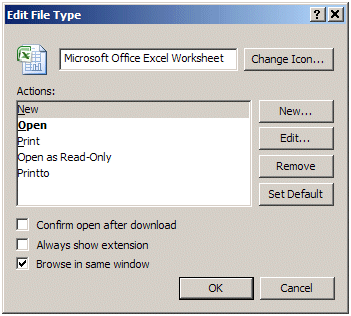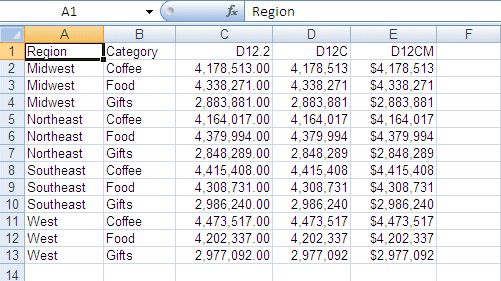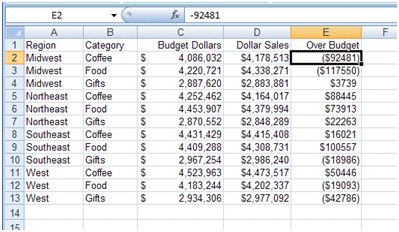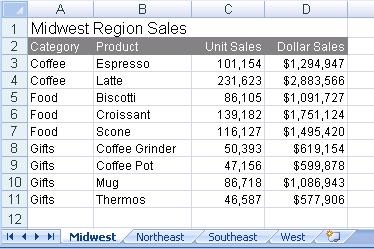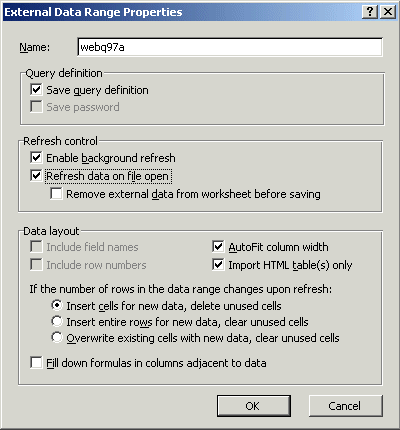You can create a WebFOCUS report
as one of several kinds of Microsoft Excel workbook.
You can specify that a report display as
an Excel worksheet when you run the report in WebFOCUS. You can
use either:
xAssigning EXL2K Format to Your Report Output
The command ON TABLE PCHOLD
FORMAT EXL2K generates a fully styled Excel report in your browser,
with conditional styling and drill-down capability.
The EXL2K (Excel 2000/2003) format is a full StyleSheet driver
that renders all report elements (for example, headings and subtotals)
as well as StyleSheet syntax (such as, conditional styling and drill-downs).
EXL2K format accurately displays formatted dates and numeric
values and controls column width and wrapping in Excel 2000/2003.
See Displaying Formatted Numeric Values in EXL2K Report Output, Passing WebFOCUS Dates to Excel 2000/2003 and Controlling Column Width and Wrapping in EXL2K Report Output.
In addition, the format variation EXL2K FORMULA enables you to
convert summed information (such as column totals, row totals, subtotals)
and calculated values to interactive formulas in an Excel 2000/2003
worksheet. See Generating Native Excel Formulas in EXL2K Report Output. Another format
variation, EXL2K PIVOT, enables you to analyze different views of
your data. See Using PivotTables in EXL2K Report Output.
EXL2K is supported only in Excel 2000 or 2003. It does not work
with any previous releases of Excel. You can invoke format EXL2K
reports using any browser supported by WebFOCUS. WebFOCUS can also run directly from Excel
without using a browser by creating a hyperlink within Excel that
calls the WebFOCUS client with the necessary parameters. For details,
see Embedding a WebFOCUS Report in an Excel 2000/2003 Workbook.
By default, when you choose EXL2K as your display format, the
report opens in an Excel 2000/2003 worksheet, identified in a tab
at the bottom of the worksheet as Sheet1, Sheet2,
and so on. You can change the name of a Sheet tab to make it more
descriptive of your report's content.
Tip: If an Excel report is launched
within a frame, the Excel toolbar options are not available. To
retain access to the toolbar when working with frames, launch the report
outside of the frameset, in a new window. For details on using target
frames, see Linking a Report to Other Resources.
Example: Creating an EXL2K Report
The
following example illustrates how to create a report in EXL2K (Excel
2000/2003) format with a styled heading, conditional styling on
SALES, and drill-downs on COUNTRY:
TABLE FILE CAR
HEADING
"SALES BY COUNTRY"
SUM SALES BY COUNTRY BY CAR BY MODEL
WHERE (COUNTRY EQ 'ENGLAND') OR (COUNTRY EQ 'ITALY') OR (COUNTRY EQ
'FRANCE');
ON TABLE PCHOLD FORMAT EXL2K
ON TABLE SET STYLE *
TYPE=REPORT, FONT=ARIAL, TITLETEXT=SALES REPORT, $
TYPE=DATA, COLUMN=COUNTRY, FOCEXEC=DRILLFEX (PARAM1=COUNTRY PARAM2=CAR),$
TYPE=DATA, COLUMN=SALES, COLOR=RED, BACKCOLOR=YELLOW, WHEN=SALES GT
10000,$
TYPE=DATA, COLUMN=MODEL, BACKCOLOR=YELLOW, WHEN=SALES GT 10000,$
TYPE=HEADING, FONT=ARIAL BLACK, COLOR=RED, BACKCOLOR=SILVER, SIZE=16, $
TYPE=TITLE, FONT=ARIAL, SIZE=12, $
ENDSTYLE
END
The output is:

Notice that the tab
name has been changed from the Excel default, Sheet1, to a more descriptive
name, which is specified in the TITLETEXT attribute of the StyleSheet.
For details on the TITLETEXT attribute see Using Headings, Footings, Titles, and Labels.
x
Reference: Usage Notes for EXL2K Output Files
Certain
EXL2K format reports, such as Pivot Tables, generate multiple output
files. The main document is returned to the browser (which opens
it in Excel), and the secondary file (such as the pivot cache file
in a Pivot Table report) is linked through a URL in the main file,
to be retrieved by an HTTP request that Excel makes to the WebFOCUS
servlet. When used with HOLD instead of PCHOLD, the output is a
single web archive file with the same .xht suffix as a normal EXL2K
HOLD file. In Excel, this file format is designated in the Save dialog
as Single File Web Page.
- If you are using Excel 2002 or later, with WebFOCUS Version
7 Release 6.9 or earlier, you can avoid having to issue this second
call by setting WEBARCHIVE=ON in any of the supported profiles or
in the procedure (fex). Certain types of EXL2K reports, such as
compound reports and reports with a table of contents (TOC), rely
on the web archive format and automatically turn WEBARCHIVE ON.
- If you are using Excel 2002 or later, with WebFOCUS Version
7 Release 6.10 or higher, by default, the WEBARCHIVE setting is
set to ON.
Note: WEBARCHIVE=ON uses a file format
that packages all of the documents into a single file.
For
additional information about redirection settings for EXCEL formats
with SET WEBARCHIVE=ON, see Microsoft Excel Report Output
Considerations in the WebFOCUS Security and Administration Manual.
x
Reference: Font Support for EXL2K Format
The
EXL2K (Excel 2000/2003) format supports fonts that are available
on the WebFOCUS client. Be sure to verify the existence of a particular
font on the client before displaying or saving a report in the EXL2K
format.
x
Identifying Null Values in EXL2K Output Files
When an EXL2K report is run, and null values are retrieved
for one or more fields, blank spaces are displayed by default in
each cell of the report output for the empty (null) fields. This
behavior is the result of SET EMPTYCELLS ON being set by default
in the background of all EXL2K reports. If you want to identify
null values with something other than blank spaces, a character
string can be used to populate all empty fields in a report.
x
Syntax: How to Identify Null Values in EXL2K Reports
To
identify null values in EXL2K reports, use
ON TABLE SET NODATA character_string
ON TABLE SET EMPTYCELLS [ON|OFF]
where:
- character_string
- Is the string of characters displayed in the cells of the report
for each field where null values are retrieved from the database.
The maximum number of characters is 11. If the number of characters
in the string exceeds the length of the output field, the additional
characters will not be displayed. If special characters are used,
the string must be enclosed in single quotes. SET EMPTYCELLS OFF
must also be specified to make the SET NODATA command effective.
- ON
- Indicates that empty spaces are displayed in the cells of the
report for each field where null values are retrieved from the database.
ON is the default.
- OFF
- Indicates that zeros, or the character string specified with
the SET NODATA command, will be displayed in the cells of the report
for each field where null values are retrieved from the database.
OFF must be specified when using SET NODATA.
Example: Identifying Null Values in EXL2K Report Output
The
following syntax utilizes the default behavior of ON TABLE SET EMPTYCELLS
ON, which is set in the background:
TABLE FILE CAR
SUM SALES BY COUNTRY ACROSS SEATS
ON TABLE PCHOLD FORMAT EXL2K
END
The following output displays empty spaces in
the cells of the report for each field where null values are retrieved
from the database:
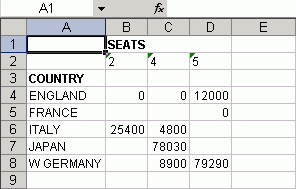
The following syntax
utilizes the SET NODATA command:
TABLE FILE CAR
SUM SALES BY COUNTRY ACROSS SEATS
ON TABLE SET NODATA 'n/a'
ON TABLE SET EMPTYCELLS OFF
ON TABLE PCHOLD FORMAT EXL2K
END
Note: If you do not add SET EMPTYCELLS
OFF, the SET NODATA command will be ignored.
The following
output displays 'n/a' in the cells of the report for each field
where null values are retrieved from the database:
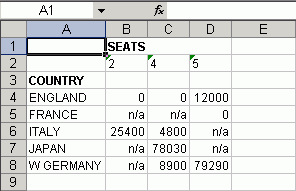
The following syntax
turns off the default SET EMPTYCELLS behavior and does not use SET
NODATA, which makes it impossible to distinguish null values from
zero quantities:
TABLE FILE CAR
SUM SALES BY COUNTRY ACROSS SEATS
ON TABLE SET EMPTYCELLS OFF
ON TABLE PCHOLD FORMAT EXL2K
END
The following output displays zeros in the cells
of the report for each field where either null values are retrieved
from the database or the quantity is zero:
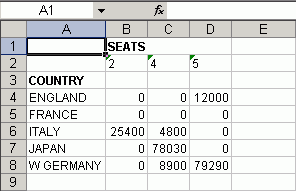
x
Displaying Formatted Numeric Values in EXL2K Report Output
Excel 2000/2003 workbooks generated by WebFOCUS EXL2K format contain the
numeric formatting specified in the Master File for the data source
or in a temporary field. WebFOCUS
numeric values (such as currency) are translated to supported Excel
formats and display properly in Excel 2000/2003.
When translating numeric formats from WebFOCUS
to Excel, there must be a corresponding Excel format to translate
to. If there is no corresponding format, then the value will be
formatted in the closest matching Excel format or in Excel General
format. For details, see Usage Notes for Numeric Formats.
Example: Displaying Formatted Numeric Data in EXL2K Report Output
The
following example illustrates how formatted numeric data displays
in a worksheet when using the EXL2K format. Note that the format
for the Fund Balance field
(D16.2M—which represents floating point double-precision with two
decimal places and a floating dollar sign) is translated to the corresponding
Excel format.
DEFINE FILE SHORT
NEWBLNC/D16.2M = BALANCE;
END
SET PAGE-NUM=OFF
TABLE FILE SHORT
"Short Term Investments"
"Excel 2000 Spreadsheet"
" "
SUM NEWBLNC AS 'Fund Balance'
BY MANAGER_ID AS 'Fund Manager'
BY TYPE
BY HOLDER
ON TABLE SET BYDISPLAY ON
ON TABLE PCHOLD FORMAT EXL2K
ON TABLE SET STYLE *
TYPE=REPORT, GRID=OFF, FONT=TAHOMA, $
TYPE=HEADING, SIZE=14, COLOR=NAVY, $
TYPE=HEADING, LINE=2, SIZE=12, COLOR=RED, $
TYPE=TITLE, JUSTIFY=CENTER, STYLE=BOLD, $
TYPE=DATA, JUSTIFY=CENTER, $
TYPE=DATA, COLUMN=NEWBLNC, JUSTIFY=RIGHT, $ END
DEFINE FILE GGSALES
NEWDOLL/D16.2M = DOLLARS;
END
SET PAGE-NUM=OFF
TABLE FILE GGSALES
"Dollar Sales"
"Excel 2000 Spreadsheet"
" "
SUM NEWDOLL AS 'Sales'
BY REGION AS 'Area'
BY CATEGORY
BY PRODUCT
WHERE REGION EQ 'Midwest' OR 'Northeast'
ON TABLE SET BYDISPLAY ON
ON TABLE HOLD AS EXL2KNUM FORMAT EXL2K
ON TABLE SET STYLE *
TYPE=REPORT, GRID=OFF, FONT=TAHOMA, $
TYPE=HEADING, SIZE=14, COLOR=NAVY, $
TYPE=HEADING, LINE=2, SIZE=12, COLOR=RED, $
TYPE=TITLE, JUSTIFY=CENTER, STYLE=BOLD, $
TYPE=DATA, JUSTIFY=CENTER, $
TYPE=DATA, COLUMN=NEWDOLL, JUSTIFY=RIGHT, $
END
The output
is:

Notice that the values of
the sort fields are repeated in the output; this presentation, which
is particularly desirable in a worksheet, is controlled by the command
ON TABLE SET BYDISPLAY ON. For details, see Sorting Tabular Reports.
x
Reference: Usage Notes for Numeric Formats
The following formats are not supported
in EXL2K. They will translate into Excel General format and possibly
produce unpredictable results:
- Fixed Dollar (N) formats.
- Multiple format options. Only single format options are supported
when using FORMAT EXL2K. For example, the formats I9C and I9B are
supported, but I9BC is not.
The following applies to
headings and footings with embedded numeric fields:
- If you embed a numeric field in a heading, subheading, footing,
or subfooting of a report in an EXL2K report, the numeric field
displays in Excel general format (text). To display a numeric field
in Excel number format, you must set HEADALIGN=BODY in the StyleSheet.
x
Passing WebFOCUS Dates to Excel 2000/2003
Excel 2000/2003 workbooks generated by WebFOCUS EXL2K format contain the
numeric formatting specified in the Master File for the data source
or in a temporary field. WebFOCUS
date formats (such as Smart Dates) are translated to supported Excel
formats and display properly in Excel 2000/2003.
When translating date formats from WebFOCUS
to Excel, there must be a corresponding Excel format to translate
to. If there is no corresponding format, then the value will be
formatted in the closest matching Excel format or in Excel General
format. For details, see Usage Notes for Date Formats.
By default, when WebFOCUS creates
dates in Excel 2000 (EXL2K) format, the date formats that contain
translated values such as month or day name are sent as formatted
text, preserving the style defined for the report field. Numeric
dates are passed to Excel 2000/2003 as standard date values, not
as text. For information about passing translated date formats to
Excel 2000/2003 as date values with format masks, see Passing Dates With Translated Text to Excel 2000/2003.
Example: Displaying Formatted Dates in EXL2K Report Output
The
following example illustrates how customized dates display in a
worksheet when using the EXL2K format.
- The format
for Month Hired is defined in the request as
MtYY (the month is represented as a 3-character abbreviation with
an initial capital letter followed by a four-digit year).
- The format for Years of Service is defined
as I4C, a four-digit integer with a comma if required. Both formats
are properly displayed as defined in the worksheet.
SET PAGE-NUM=OFF
DEFINE FILE EMPLOYEE
YRHIRED/YY = HIRE_DATE;
MHIRED/MtYY = HIRE_DATE;
TOTSVC/I4C = 2002 - YRHIRED;
END
TABLE FILE EMPLOYEE
"Employee Service Report for 2002"
"Excel 2000 Spreadsheet"
" "
PRINT FIRST_NAME AS 'First Name'
MHIRED AS 'Month Hired'
TOTSVC AS 'Years of Service'
BY LAST_NAME AS 'Last Name'
ON TABLE SET BYDISPLAY ON
ON TABLE PCHOLD FORMAT EXL2K
ON TABLE SET STYLE *
TYPE=REPORT, GRID=OFF, FONT=TAHOMA, $
TYPE=HEADING, SIZE=14, COLOR=NAVY, $
TYPE=HEADING, LINE=2, SIZE=12, COLOR=RED, $
TYPE=TITLE, JUSTIFY=CENTER, STYLE=BOLD, $
TYPE=DATA, JUSTIFY=CENTER, $
TYPE=DATA, COLUMN=TOTSVC, COLOR=BLUE, WHEN=TOTSVC GT 20, $
END
The output is:
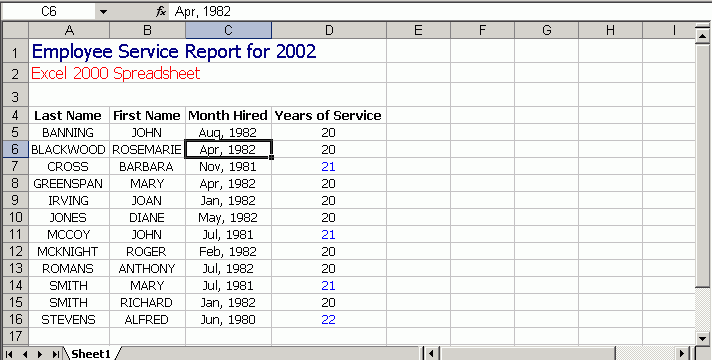
The command ON TABLE
SET BYDISPLAY ON ensures that sort fields are repeated in each worksheet
cell. For details, see Sorting Tabular Reports.
x
Reference: Usage Notes for Date Formats
The following formats are not supported
in EXL2K. They will translate into Excel General format and possibly
produce unpredictable results:
- YY, Y, M, D, JUL, and I2MT.
- Any date format with a Q (quarter).
- Any packed-decimal (P) date formats.
- Any alphanumeric (A) date formats.
x
Reference: Using Date Separators in Excel
In
order to use a "-" as a separator between month, day, and year in
Excel 2000/2003, you must change the default date separator for
Windows. This setting can be located under Regional Options in the
Control Panel.
x
Passing Dates With Translated Text to Excel 2000/2003
Some translated dates can be sent to Excel 2000/2003
as standard date values with format masks, enabling Excel to use
them in functions, formulas, and sort sequences. The SET EXL2KTXTDATE
command allows you to specify that translated dates should be sent
as date values with format masks instead of text values.
x
Syntax: How to Pass Translated Dates to Excel 2000/2003 as Date Values
SET EXL2KTXTDATE = {TEXT|VALUE}where:
- TEXT
- Passes date values that contain text to Excel 2000/2003 as formatted
text. TEXT is the default value.
- VALUE
- Passes the types of translated date values that contain text
and are supported Excel date formats to Excel 2000/2003 as standard
date values with text format masks applied.
x
Reference: Usage Notes for SET EXL2KTXTDATE
- The following date formats are not supported in EXL2K. They
will translate into Excel General format and possibly produce unpredictable
results:
- JUL, YYJUL, and I2MT.
- Dates stored as a packed or alphanumeric field with date display options.
- Excel only supports mixed-case, not all uppercase or all lowercase
for text dates. When EXL2KTXTDATE is set to VALUE, all WebFOCUS date formats containing text
will present in EXL2K as mixed-case, regardless of the casing parameters
defined in the WebFOCUS format. For example, MTRDY will
generate the date string JANUARY 2, 10 in standard WebFOCUS, but when sent to EXL2K as
a date value, it will be presented as January 2, 10.
Example: Passing Dates With Translated Text to Excel 2000/2003
The following request against the GGSALES
data source creates the date January 1, 2010 and converts it to
four date formats with translated text:
SET EXL2KTXTDATE=TEXT
DEFINE FILE GGSALES
NEWDATE/MDYY = '01/01/2010';
WRMtrDY/WRMtrDY = NEWDATE;
wDMTY/wDMTY= NEWDATE;
wrDMTRY/wrDMTRY= NEWDATE;
wrYMtrD/wrYMtrD= NEWDATE;
END
TABLE FILE GGSALES
SUM DATE NOPRINT
NEWDATE WRMtrDY wDMTY wrDMTRY wrYMtrD
ON TABLE PCHOLD FORMAT EXL2K
END
The following table shows
how the dates should appear with EXL2KTXTDATE set to TEXT and to
VALUE.
WebFOCUS Format | SET EXL2KTXTDATE=TEXT | SET EXL2KTXTDATE=VALUE |
|---|
EXL2K Displays: | EXL2K Value: | EXL2K Displays: | EXL2K Value: |
|---|
WRMtrDY | FRIDAY, January 1 10 | FRIDAY, January 1 10 | Friday, January 1 10 | 1/1/2010 |
wDMTY | Fri, 1 JAN 10 | Fri, 1 JAN 10 | Fri, 1 Jan 10 | 1/1/2010 |
wrDMTRY | Friday, 1 JANUARY 10 | Friday, 1 JANUARY 10 | Friday, 1 January 1 | 1/1/2010 |
wrYMtrD | Friday, 10 January 1 | Friday, 10 JANUARY 1 | Friday, 10 January 1 | 1/1/2010 |
With SET EXL2KTXTDATE=TEXT,
in EXL2K report output all the cells with month or day translation
are sent as text, and all month and day names are in the case specified
by the WebFOCUS format. The output
is:

With
SET EXL2KTXTDATE=VALUE, in EXL2K report output all of the cells
have a date value with format masks, and all month and day names
are in mixed-case, regardless of how the case has been specified
in the WebFOCUS format. The output
is:

x
Passing Dates Without a Day Component
Date formats that do not specify the day value explicitly
are defined as the date value of the first day of the month. Therefore,
the value placed in the cell may be different from the day component
value in the source data field and may produce unexpected results
when used for sorting or date calculations in an Excel formula.
The following table shows how WebFOCUS date formats are represented in
EXL2K report output. The table shows how the value is preserved
in the cell and how the display is generated using the format mask
that corresponds to the WebFOCUS date
format.
DATEFLD/MDYY = '01/02/2010'
WebFOCUS Format | SET EXL2KTXTDATE=TEXT | SET EXL2KTXTDATE=VALUE |
|---|
EXL2K Displays: | EXL2K Value: | EXL2K Displays: | EXL2K Value: |
|---|
DMYY | 02/01/2010 | 1/2/2010 | 02/01/2010 | 1/2/2010 |
MY | 01/10 | 1/1/2010 | 01/10 | 1/1/2010 |
MTY | JAN, 10 | JAN, 10 | Jan, 10 | 1/1/2010 |
MTDY | JAN 2, 10 | JAN 2, 10 | Jan 2, 10 | 1/2/2010 |
Example: Passing WebFOCUS Dates With and Without a Day Component to Excel 2000/2003
The following request against the GGSALES
data source creates the date January 2, 2010 and passes it to Excel
2000/2003 with formats MDYY, DMYY, MY, and MTDY:
SET EXL2KTXTDATE=TEXT
DEFINE FILE GGSALES
NEWDATE/MDYY = '01/02/2010';
END
TABLE FILE GGSALES
SUM DATE NOPRINT
NEWDATE AS 'MDYY' NEWDATE/DMYY AS 'DMYY' NEWDATE/MY
AS 'MY' NEWDATE/MTY AS 'MTY' NEWDATE/MTDY AS 'MTDY'
ON TABLE PCHOLD FORMAT EXL2K
ENDWith EXL2KTXTDATE=TEXT,
columns D and E have a text values, not date values. The values
are displayed in uppercase as specified by the WebFOCUS
formats (MTY and MTDY):

With
EXL2KTXTDATE=VALUE, columns D and E have actual date values with
format masks, displayed by Excel 2000 in mixed-case. Since the MTY
format does not have a day component, the date value stored is the
first of January 2010 (1/1/2010), not the second of January 2010
(1/2/2010):

x
Passing Date Components for Use in EXL2K FORMULA Reports
Dates formatted as individual components (for example,
D, Y, M, W) are passed to Excel 2000/2003 as numeric values that
can be used as parameters to Excel date functions. The values are
passed as general text format that are recognized by Excel 2000/2003
as numbers. These values are passed to Excel in the same format
regardless of the setting for EXL2KTXTDATE.
Example: Passing Numeric Date Components to Excel 2000/2003
The following request against the GGSALES
data source creates the date January 1, 2010 and extracts numeric
date components, passing them to Excel 2000/2003:
SET EXL2KTXTDATE=VALUE
DEFINE FILE GGSALES
NEWDATE/MDYY = '01/01/2010';
D/D= NEWDATE;
Y/Y = NEWDATE;
W/W=NEWDATE;
w/w=NEWDATE;
M/M = NEWDATE;
YY/YY = NEWDATE;
END
TABLE FILE GGSALES
SUM DATE NOPRINT
NEWDATE D Y W w M YY
ON TABLE PCHOLD FORMAT EXL2K
END
With SET EXL2KTXTDATE=VALUE,
the output is:

x
Date formats that contain a Quarter component are always
passed to Excel as text strings since Excel does not support Quarter
formats.
Example: Passing Dates With a Quarter Component to Excel 2000/2003
The following request against the GGSALES
data source creates the date January 1, 2010 and converts it to
date formats that contain a Quarter component:
SET EXL2KTXTDATE=VALUE
DEFINE FILE GGSALES
NEWDATE/MDYY = '01/01/2010';
Q/Q= NEWDATE;
QY/QY = NEWDATE;
YBQ/YBQ=NEWDATE;
END
TABLE FILE GGSALES
SUM DATE NOPRINT
NEWDATE Q QY YBQ
ON TABLE PCHOLD FORMAT EXL2K
END
Even with SET EXL2KTXTDATE=VALUE, in the EXL2K
report output, the cells containing dates with Quarter components
have General format. To see this, open the Format Cells dialog box.
The output is:

x
Passing Date Components Defined as Translated Text
Date formats that do not contain
sufficient information to present the valid date result in Excel
are not translated to a value, including formats that do not contain
year and/or month information. These dates will continue to be sent
to Excel 2000/2003 as text regardless of the SET EXL2KTXTDATE setting.
In the absence of complete information, the year defaults to the
current year, so the value sent would be incorrect if this type
of format was passed as a date value. The following formats will
not be sent as values:
- MT, MTR, Mt, Mtr
- W, w, WR, wr
Note that since these values are always sent as text, the casing
defined in the WebFOCUS format is
applied in the resulting cell.
Example: Passing Date Components Defined as Translated Text to Excel 2000/2003
The following request against the GGSALES
data source creates the date January 1, 2010 and converts it to
date formats that are defined as either month name or day name:
SET EXL2KTXTDATE=VALUE
DEFINE FILE GGSALES
NEWDATE/MDYY = '01/01/2010';
MT/MT= NEWDATE;
MTR/MTR= NEWDATE;
Mtr/Mtr = NEWDATE;
WR/WR = NEWDATE;
wr/wr = NEWDATE;
END
TABLE FILE GGSALES
SUM DATE NOPRINT
NEWDATE MT MTR Mtr WR wr
ON TABLE PCHOLD FORMAT EXL2K
END
In Excel 2000/2003, the cells containing the days
have General format. To see this, open the Format Cells dialog box.
The output is:

x
Controlling Column Width and Wrapping in EXL2K Report Output
Data wrapping, column width, and the scroll area can
be controlled in an Excel 2000/2003 worksheet when using FORMAT
EXL2K. You can:
- Turn data wrapping on. The default behavior is for all data
to wrap according to a default column width that is determined by
Excel.
- Turn data wrapping off. This setting allows columns to expand
to the length of the data value. The column width is determined
by Excel, but should be wide enough to fit the longest data value
in the column. If a portion of the data is hidden, you can adjust the
column width in Excel after the worksheet has been generated.
- Turn data wrapping off and set the column width at the same
time. If a data value is wider than the specified width of the column,
a portion of the data will be hidden from view. You can adjust the
column width in Excel after the worksheet has been generated.
- Specify the exact width of a column with data wrapping on.
For details on WRAP and SQUEEZE syntax,
see Formatting Report Data.
x
Syntax: How to Wrap Data in EXL2K Report Output
TYPE=REPORT, [COLUMN=column,] WRAP=value, $
where:
- column
- Designates a particular column to apply wrapping behavior to.
If COLUMN is not included in the declaration, wrapping will be applied
to the entire report.
- value
- Is one of the following:
- ON
- Turns on data wrapping. ON is the default value. With this setting,
the column width is determined by the client (Excel). Data wraps
if it exceeds the width of the column and the row's height expands
to meet the new height of the wrapped data.
- OFF
- Turns off data wrapping. This setting adjusts the column width
of the largest data value in the column. Data will not wrap in any
cell in the column.
- n
- Represents a specific numeric value that the column width can
be set to. The value represents the measure specified with the UNITS
parameter (the default is inches).
This setting implies ON. However,
the column width is set to the specified width unless the data is
wider than the column width, in which case, wrapping will occur
as for ON.
x
Syntax: How to Set Column Width in EXL2K Report Output
TYPE=REPORT, [COLUMN=column,] SQUEEZE={ON|OFF|n}, $where:
- column
- Identifies a particular column. If COLUMN is not included in
the declaration, default SQUEEZE behavior is applied to the entire
report.
- n
- Represents a specific numeric value that the column width can
be set to. The value represents the measure specified with the UNITS
parameter (the default is inches).
This is the most commonly used
SQUEEZE setting in an EXL2K report.
Note:
- ON/OFF settings for SQUEEZE are not meaningful for EXL2K, and
both produce the default behavior.
- SQUEEZE = n turns off data wrapping. If a data value
is wider than the specified width of the column, it is hidden from
view. You can adjust column width in Excel after the worksheet has
been generated.
- SQUEEZE is not supported for columns created with the OVER phrase.
Example: Controlling Column Width and Wrapping in EXL2K Report Output
The
following example illustrates how to turn on and turn off data wrapping
in a column and how to set the column width for a particular column.
The UNITS in this example are set to inches (the default).
DEFINE FILE CAR
MYDATE/MDY='10/22/60';
RCD/D14.3=RETAIL_COST;
VERYLONG/A80='Subtract dealer cost from retail cost to calculate
profit.';
END
TABLE FILE CAR
PRINT MYDATE RCD
VERYLONG AS 'Default' VERYLONG AS 'WRAP=OFF'
VERYLONG AS 'WRAP=4.1' VERYLONG AS 'WRAP=2'
VERYLONG AS 'SQUEEZE=2' SALES
BY COUNTRY
ON TABLE PCHOLD FORMAT EXL2K
ON TABLE SET STYLE *
TYPE=DATA, COLUMN=MYDATE, JUSTIFY=CENTER, $
1. TYPE=REPORT, COLUMN=VERYLONG(2), WRAP=OFF, $
2. TYPE=REPORT, COLUMN=VERYLONG(3), WRAP=4.1, $
3. TYPE=REPORT, COLUMN=VERYLONG(4), WRAP=2, $
4. TYPE=REPORT, COLUMN=VERYLONG(5), SQUEEZE=2, $
END
where:
- Identifies the column titled "WRAP=OFF" and turns off data wrapping
for that column.
- Identifies the column titled "WRAP=4.1" and sets the column
width to 4.1 inches with data wrapping on.
- Identifies the column titled "WRAP=2" and sets the column width
to 2 inches with data wrapping on.
- Identifies the column titled "SQUEEZE=2" and sets the column
width to 2 inches with data wrapping off.
Note: The
column titled "Default" illustrates the default column width and wrapping
behavior.
Since the output is wider than this page, it is
shown in two sections. The following output displays the "Default",
"WRAP=OFF", and "WRAP=4.1" columns:

The following output
displays the "WRAP=2", and "SQUEEZE=2" columns:
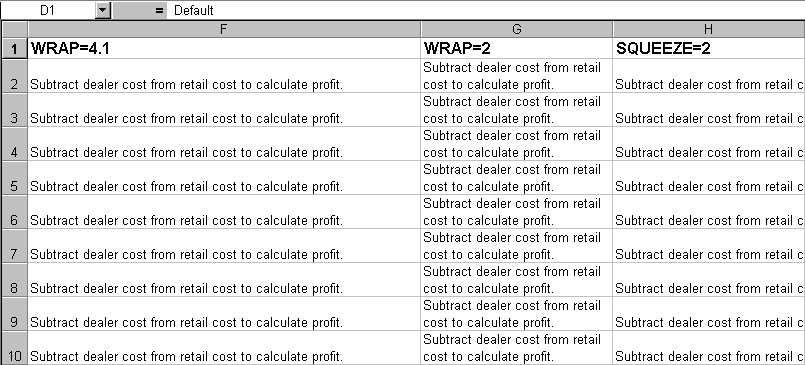
x
Locking Columns in EXL2K Report Output
Using StyleSheet attributes, you can lock Excel workbook
values so they are read-only. These attributes apply to all EXL2K
formats including EXL2K, EXL2K PIVOT, and EXL2K FORMULA.
x
Syntax: How to Enable Worksheet Locking
To enable locking, use the following attributes:
TYPE=REPORT, PROTECTED={ON|OFF}, [LOCKED={ON|OFF}],$where:
- TYPE=REPORT,
PROTECTED=ON
- Is necessary to enable worksheet locking. PROTECTED=OFF is
the default. If you omit the LOCKED=OFF attribute, the entire worksheet
is locked.
- LOCKED=ON
- Locks the entire worksheet. ON is the default value.
- LOCKED=OFF
- Unlocks the worksheet as a whole, but enables you to lock or
unlock specific cells or groups of cells.
x
Syntax: How to Lock Specific Cells Within a Worksheet
Once you include the following declaration
in your StyleSheet, you can specify the LOCKED attribute for specific
cells or groups of cells:
TYPE=REPORT, PROTECTED=ON, LOCKED=OFF,$
To lock specific parts of the worksheet,
add the LOCKED=ON attribute to the StyleSheet declaration for the
cells you want to lock.
TYPE=type, [ COLUMN=columnspec ] ,LOCKED={ON|OFF},$where:
- type
- Is the type of element that describes the cells to be locked.
- columnspec
- Is a valid column specification.
Example: Locking an Entire EXL2K Workbook
The following request locks the entire
workbook because the StyleSheet declarations include the following
declaration:
TYPE=REPORT, PROTECTED=ON, $
The request is:
TABLE FILE CAR
HEADING
"Profit By Car "
" "
SUM RETAIL_COST AND DEALER_COST AND
COMPUTE PROFIT/D12.2 = RETAIL_COST - DEALER_COST;
BY CAR
ON TABLE SET PAGE-NUM OFF
ON TABLE PCHOLD AS EXLFORM1 FORMAT EXL2K
ON TABLE SET STYLE *
TYPE=REPORT, COLOR=BLUE, BACKCOLOR=SILVER, SIZE=9,$
TYPE=REPORT, PROTECTED=ON, $
TYPE=HEADING, STYLE=BOLD, SIZE=14, $
TYPE=TITLE, STYLE=BOLD, SIZE=11,$
ENDSTYLE
END
You cannot edit any value on the worksheet.
Any attempt to do so displays a message that the sheet is protected:
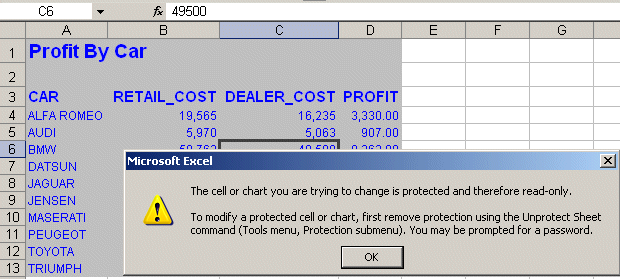
Example: Locking a Single Column on an EXL2K Workbook
The following request locks the second
column (RETAIL_COST) because the StyleSheet declarations include
the following declarations:
TYPE=REPORT, PROTECTED=ON, LOCKED=OFF, $
TYPE=DATA, COLUMN=2, LOCKED=ON,$
The
request is:
TABLE FILE CAR
HEADING
"Profit By Car "
" "
SUM RETAIL_COST AND DEALER_COST AND
COMPUTE PROFIT/D12.2 = RETAIL_COST - DEALER_COST;
BY CAR
ON TABLE SET PAGE-NUM OFF
ON TABLE PCHOLD AS EXLFORM2 FORMAT EXL2K
ON TABLE SET STYLE *
TYPE=REPORT, COLOR=BLUE, BACKCOLOR=SILVER, SIZE=9,$
TYPE=REPORT, PROTECTED=ON, LOCKED=OFF,$
TYPE=HEADING, STYLE=BOLD, SIZE=14, $
TYPE=TITLE, STYLE=BOLD, SIZE=11,$
TYPE=DATA, COLUMN=2, LOCKED=ON,$
ENDSTYLE
END
You cannot edit any value in column
2, although you can edit values in other columns. Any attempt to
edit a value in column 2 displays a message that the cells are protected:
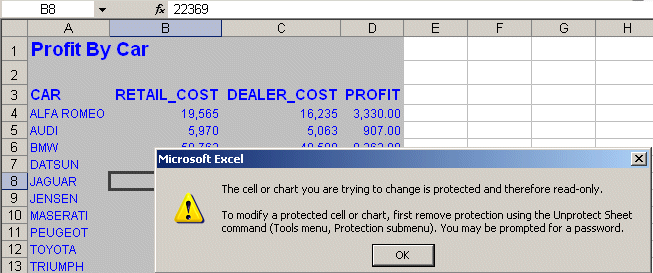
x
Generating Native Excel Formulas in EXL2K Report Output
When you display or save a tabular report request using
EXL2K FORMULA, the resulting worksheet contains an Excel formula
that computes and displays the results of any type of summed information
(such as column totals, row totals, subtotals, and calculated values),
rather than static numbers. Worksheets saved using the EXL2K FORMULA
format are interactive, allowing for "what if" scenarios that immediately
reflect any additions or modifications made to the data.
The EXL2K FORMULA format is supported for the WebFOCUS TABLE commands: ROW-TOTAL,
COLUMN-TOTAL, SUB-TOTAL, SUBTOTAL, SUMMARIZE, RECOMPUTE, and COMPUTE,
and for calculations performed by functions. See Translation Support for FORMAT EXL2K FORMULA.
EXL2K FORMULA is not supported with PivotTables (EXL2K
PIVOT), with Excel 97 (EXL97), or with financial reports created
with the Financial Report Painter or the underlying Financial Modeling
Language (FML).
x
Syntax: How to Save Reports as FORMAT EXL2K FORMULA
Add
the following syntax to your request to take advantage of Excel
formulas in your workbook:
ON TABLE {PCHOLD|HOLD} FORMAT EXL2K FORMULAwhere:
- PCHOLD
- Displays the output in an EXL2K workbook.
- HOLD
- Saves the output for reuse in an Excel 2000/2003 worksheet.
For details, see Saving and Reusing Your Report Output.
Example: Generating Native Excel Formulas for Column Totals
The following example illustrates how
a column total in a report request is translated to an Excel formula
when you use the format EXL2K FORMULA. Notice that the formatting of
the column total (TYPE=GRANDTOTAL) is retained in the Excel 2000/2003
workbook.
When you
select the total in the report, the equation =SUM(B4:B10) displays
in the formula bar, representing the column total as a sum of cell
ranges.
TABLE FILE SHORT
HEADING
"Projected Return By Region"
" "
SUM PROJECTED_RETURN AS 'RETURN'
BY REGION AS 'REGION'
ON TABLE COLUMN-TOTAL
ON TABLE SET STYLE *
TYPE=REPORT, COLOR=BLUE, BACKCOLOR=SILVER, SIZE=9,$
TYPE=HEADING, STYLE=BOLD, SIZE=14, $
TYPE=TITLE, STYLE=BOLD+UNDERLINE, SIZE=10,$
TYPE=GRANDTOTAL, STYLE=BOLD, $
ENDSTYLE
ON TABLE PCHOLD FORMAT EXL2K FORMULA
END
The output is:
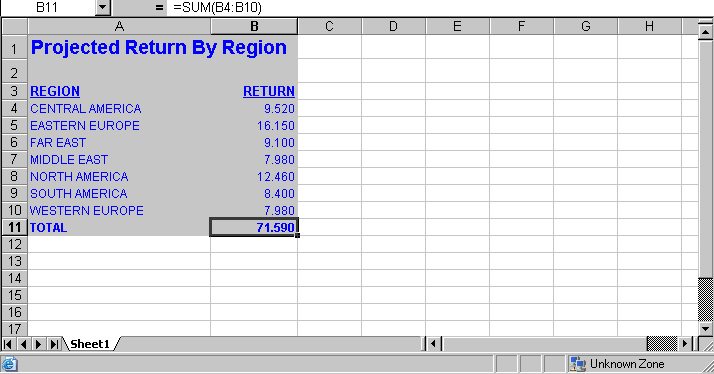
You can translate any
total (subtotal, row total, or column total) to an Excel formula. For
related information, see Translation Support for FORMAT EXL2K FORMULA.
Example: Generating Native Excel Formulas for Row Totals
This request calculates totals for returns
and balances across continents. The row totals are represented as
sums of cell ranges.
TABLE FILE SHORT
HEADING
"Projected Return Across Continent"
" "
SUM PROJECTED_RETURN AS 'RETURN' AND BALANCE AS 'BALANCE'
ACROSS CONTINENT AS 'CONTINENT'
BY REGION AS 'REGION'
ON CONTINENT ROW-TOTAL AS 'TOTAL'
ON TABLE COLUMN-TOTAL AS 'TOTAL'
ON TABLE SET STYLE *
TYPE=REPORT, COLOR=BLUE, BACKCOLOR=SILVER, SIZE=9,$
TYPE=HEADING, STYLE=BOLD, SIZE=14, $
TYPE=TITLE, STYLE=BOLD, SIZE=11,$
TYPE=SUBTOTAL,STYLE=BOLD, $
TYPE=GRANDTOTAL,STYLE=BOLD,SIZE=11,$
TYPE=ACROSSTITLE,STYLE=BOLD,SIZE=11,JUSTIFY=LEFT,$
TYPE=ACROSSVALUE,STYLE=BOLD,SIZE=10,JUSTIFY=CENTER,$
ENDSTYLE
ON TABLE PCHOLD FORMAT EXL2K FORMULA
END
The following output highlights
the formula that calculates the row total in cell I12=C12+E12+G12:
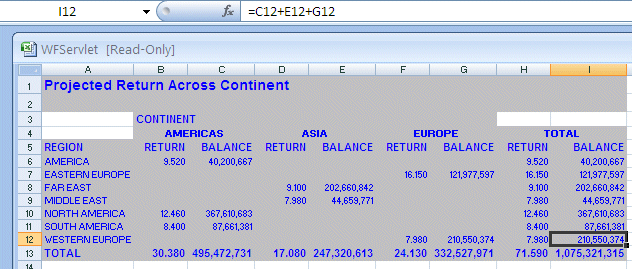
Example: Generating Native Excel Formulas for Calculated Values
This request totals the columns for
retail cost and dealer cost and calculates the value of a field
called PROFIT by subtracting the dealer cost from the retail cost.
The
formula for the calculated values is generated by translating the
internal form of the WebFOCUS expression
(COMPUTE PROFIT/D12.2 = RC - DC;) into an Excel formula. In this
example, the formulas appear in cells B14, C14, and D14.
TABLE FILE CAR
ON TABLE SET PAGE-NUM OFF
SUM RC AND DC AND
COMPUTE PROFIT/D12.2 = RC - DC;
BY CAR
HEADING
"Profit By Car"
" "
ON TABLE COLUMN-TOTAL
ON TABLE PCHOLD FORMAT EXLL2K FORMULA
ON TABLE SET STYLE *
TYPE=REPORT, COLOR=BLUE, BACKCOLOR=SILVER, SIZE=9,$
TYPE=HEADING, STYLE=BOLD, SIZE=14, $
TYPE=TITLE, STYLE=BOLD, SIZE=11,$
TYPE=GRANDTOTAL, STYLE=BOLD, SIZE=11,$
ENDSTYLE
END
The following output highlights
the formula that calculates for the column total of PROFIT: D14=SUM(D4:D13).
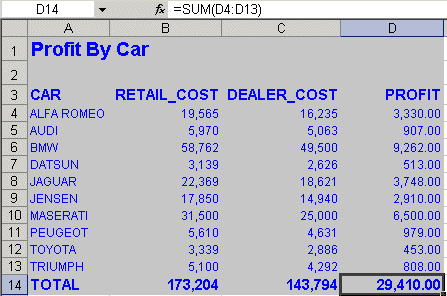
Example: Generating a Native Excel Formula for a Function
The
following illustrates how functions are translated to Excel 2000/2003
reports. The function DMOD divides ACCTNUMBER by 1000 and returns
the remainder to LAST3_ACCT. The Excel formula corresponds to this,
=TRUNC((MOD($C3,(1000)))).
TABLE FILE EMPLOYEE
PRINT ACCTNUMBER AS 'Account Number' AND COMPUTE
LAST3_ACCT/I3L = DMOD(ACCTNUMBER, 1000, LAST3_ACCT);
BY LAST_NAME AS 'Last Name'
BY FIRST_NAME AS 'First Name'
WHERE (ACCTNUMBER NE 000000000) AND (DEPARTMENT EQ 'MIS');
ON TABLE PCHOLD FORMAT EXL2K FORMULA
ON TABLE SET STYLE *
TYPE=TITLE, SIZE=12, STYLE=BOLD, $
END
The output is:
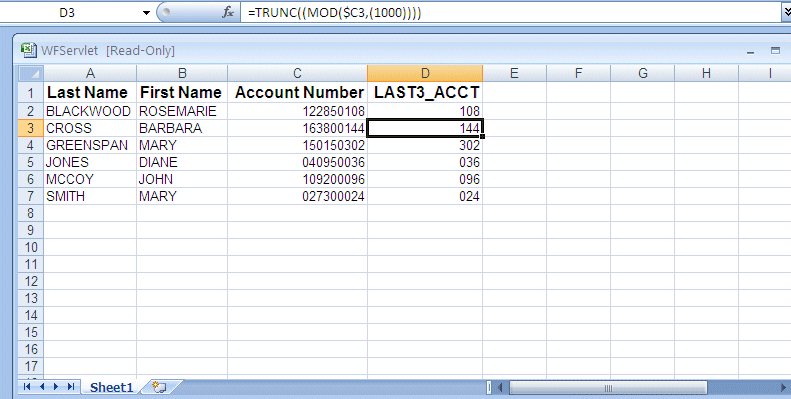
x
Reference: Translation Support for FORMAT EXL2K FORMULA
- All standard operators are supported.
These include arithmetic operators, relational operators, string
operators, IF/THEN/ELSE, and logical operators. However, prefix
operators are not supported and column notation is not supported.
The IS-PRESENT, IS-MISSING, CONTAINS,
and OMITS operators are not supported. In addition the logical operators
(AND, OR) are not supported within IF/THEN/ELSE statements.
- The following functions are supported:
ABS,
ARGLEN, ATODBL, BYTVAL, CHARGET, CTRAN, CTRFLD, DECODE DMOD, DOWK,
DOWKI, DOWKL, DOWKLI, EDIT (1 argument variant only), EXP, EXPN,
FMOD, HEXBYT, HHMMSS, IMOD, INT, LCWORD, LJUST, LOCASE, LOG, MAX,
MIN, OVRLAY, POSIT, RDUNIF, RANDOM, RJUST, SQRT, SUBSTR, TODAY,
TODAYI, UPCASE, YM. The EDIT function is not supported for editing
strings.
If you use the COMPUTE command with an unsupported
function, an error message is displayed.
- EXL2K FORMULA is not supported with
the following WebFOCUS commands and
phrases:
- DEFINE.
- OVER.
- NOPRINT. If your report contains a calculated value (generated
by the COMPUTE or RECOMPUTE command), all of the fields referenced
by the calculated value must be displayed in the report.
- Multiple display (PRINT, LIST, SUM, and COUNT) commands.
- SEQUENCE.
- RECAP.
- Prefix operators.
- SET SUBTOTALS = ABOVE.
- Formulas for ROW-TOTALs are represented by addition of specific
cells, while formulas for COLUMN-TOTALs are represented as sums
of cell ranges. For example, =SUM(G2:G10).
- A formula for a calculated value is generated by translating
the internal form of the WebFOCUS
expression into an Excel formula.
- The setting BYDISPLAY ON is recommended, otherwise the sort
field value will not be available on all rows for recalculations.
- Excel 2000/2003 formulas are limited to 1024 characters. Therefore,
the translation to an Excel formula will fail if a WebFOCUS total or the result of an
expression requires more than 1024 bytes of Excel formula code and
an error message will be generated.
- Conditional styling is based on the values in the original report.
If the worksheet values are changed and the formulas are recomputed,
the styling will not reflect the updated information.
x
Using PivotTables in EXL2K Report Output
The power of EXL2K format derives in large measure from
its ability to take advantage of PivotTables. The PivotTable is
a tool used in Microsoft Excel to analyze complex data much like the OLAP tool in WebFOCUS.
It allows you to drag and drop data fields within a PivotTable,
providing different views of the data, such as sorting across rows
or columns. You can also create dimensional hierarchies, similar
to those created using WITHIN syntax, by using the PAGEFIELDS command.
For information about WITHIN syntax, see the Describing Data With WebFOCUS Language manual.
Report requests can be created in WebFOCUS and sent as output to a fully formatted Excel PivotTable. The ON TABLE PCHOLD FORMAT EXL2K PIVOT command will generate an Excel PivotTable in your browser.
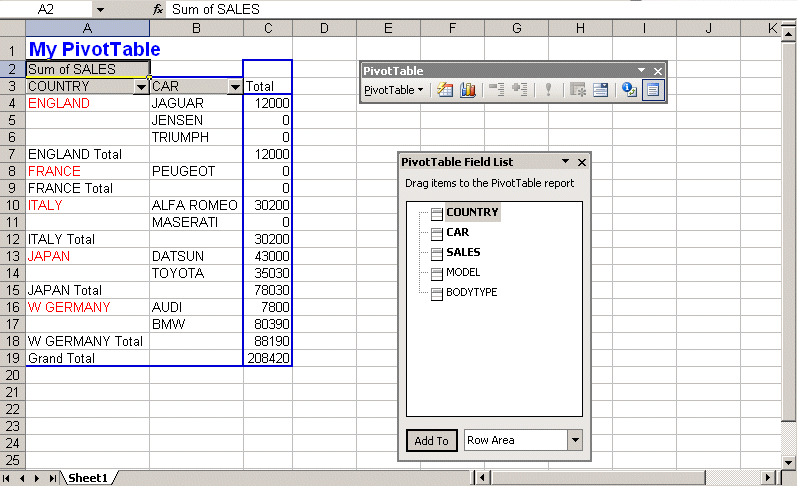
When FORMAT EXL2K PIVOT is enabled, two data streams are created:
- The first data stream is the PivotTable file.
The PivotTable file (.xht) is an HTML file with embedded XML. The HTML file contains all the information that is displayed in your browser.
- The second data stream is the PivotTable cache file (.xml).
The PivotTable cache file is a metadata type of file. It contains all the fields specified in the procedure and links internally to the PivotTable file. The PivotTable cache file can contain data fields called CACHEFIELDS, which populate the PivotTable toolbar, but do not initially display in the report. CACHEFIELDS can be dragged and dropped from the PivotTable toolbar into the PivotTable when required for analysis. The two data streams are packaged into one output file when the WEBARCHIVE parameter is set to ON. ON is the WEBARCHIVE parameter default value.
For details on the WEBARCHIVE parameter, see the Developing Reporting Applications manual.
Note: Distributing EXL2K PIVOT reports
with ReportCaster requires the WEBARCHIVE parameter to be set to
ON.
x
Procedure: How to View the PivotTable Toolbar in Excel 2000/2003
The
PivotTable toolbar may not automatically display when a PivotTable
is created. To display the PivotTable toolbar, use the following
procedure:
-
Click View in the Excel toolbar.
-
Highlight Toolbars.
-
Click PivotTable.
Excel 2000/2003 displays the PivotTable toolbar, listing
the fields available to be dragged into the body of the PivotTable
report. A cell within the PivotTable must be selected for the Pivot
toolbar to display all fields.
x
Reference: How TABLE Elements Appear in a Pivot Table
The
PivotTable is generated by the PRINT command in combination with
the BY, ACROSS, PAGEFIELDS and CACHEFIELDS phrases. It contains
all options used to design and format the report, as well as fields
specified in the PIVOT request. Fields can be dragged into the report
from the toolbar. The following graphic depicts PivotTable output
with the major elements identified.

The following summary
table shows PivotTable elements and the associated FOCUS syntax.
|
PivotTable Element
|
Contains...
|
Function
|
Generating Syntax
|
|---|
|
Page field
|
Field that controls view of the entire page (worksheet).
|
A filtering mechanism to conduct a high
level sort.
|
PAGEFIELDS phrase
|
|
Page field item
|
The value for a page field item displays in
a drop-down list.
|
Selecting a page field item summarizes data
for the entire report.
|
PAGEFIELDS phrase
|
|
Data field
|
Numeric data that is available to be summarized.
|
Holds data available to be summarized.
|
PRINT command
|
|
Column field
|
Horizontal sort data.
|
Sorts data horizontally.
|
ACROSS command
|
|
Row field
|
Vertical sort data.
|
Sorts data vertically.
|
BY command
|
x
Reference: Effect of TABLE Syntax Elements on PivotTables
The
following table summarizes TABLE syntax elements that are supported
in EXL2K PIVOT. The effect of each command on your PivotTable request
is listed, along with required usage.
|
Syntax Element
|
Usage
|
Effect on PivotTable
|
|---|
|
PRINT
|
Required.
|
Designates the data field in a PivotTable.
|
|
BY
|
Optional. *
|
Designates row field in a PivotTable.
|
|
ACROSS
|
Optional. *
|
Designates a column field in a PivotTable.
|
|
CACHEFIELDS
|
Optional. *
|
Places fields in the Pivot cache file and makes
them available from the Pivot toolbar.
|
|
PAGEFIELDS
|
Optional. *
|
Designates a Page field in a PivotTable.
|
* You need at least one sort field or a PAGEFIELD
for a valid Pivot Table.
x
The standard HOLD and SAVE syntax for storing the output
file on disk is supported for the EXL2K PIVOT file format. When
FORMAT EXL2K PIVOT is enabled, two files are created, the PivotTable
file (.xht) and a PivotTable cache file (.xml). The PivotTable cache file
contains all the fields specified in the procedure and links internally
to the PivotTable file. All available fields can be viewed in the
PivotTable toolbar.
You can include the CACHEFIELDS phrase in a request to add fields
to the pivot cache that are not initially displayed in the report.
The cache file enables you to add available fields from the PivotTable
toolbar into the body of the PivotTable by dragging and dropping.
You can remove fields from the PivotTable by dragging and dropping
them anywhere outside the report. Using these tools, you can quickly
vary data views.
x
Syntax: How to Enable the PivotTable
The
following are syntax variations that you can use to enable FORMAT
EXL2K PIVOT.
- To view the output immediately in Excel
2000/2003:
ON TABLE PCHOLD FORMAT EXL2K PIVOT
- To store output on disk for later viewing
ON TABLE HOLD FORMAT EXL2K PIVOT AS mypivot
where:
- mypivot
- Is a name you assign to the HOLD file.
Two
files are generated with this syntax:
- MYPIVOT.XHT is
the main file that is displayed in the browser or Excel window.
- MYPIVO$.XML is the Pivot Cache file.
x
Reference: Usage Notes for PivotTable Requests
You should consider the following when
writing requests for output to a PivotTable:
Example: Populating a PivotTable
The
following example illustrates how to generate a PivotTable:
TABLE FILE CAR
HEADING
"CAR File PivotTable"
"Sum of Sales by Car Across Model"
PRINT SALES
BY CAR
ACROSS MODEL
ON TABLE COLUMN-TOTAL
ON TABLE SET STYLE *
TYPE=HEADING, LINE=1, FONT='ARIAL', COLOR=PURPLE, SIZE=16, STYLE=BOLD,$
TYPE=HEADING, LINE=2, FONT='ARIAL', COLOR=PURPLE, SIZE=12, STYLE=BOLD,$
TYPE=DATA, FONT='ARIAL', COLOR=PURPLE,$
TYPE=GRANDTOTAL, FONT='ARIAL', COLOR=PURPLE, SIZE=16, STYLE=BOLD,$
ENDSTYLE
ON TABLE PCHOLD AS CARPIVOT FORMAT EXL2K PIVOT
PAGEFIELDS COUNTRY
CACHEFIELDS RETAIL_COST TYPE
END
The command ON TABLE PCHOLD
FORMAT EXL2K PIVOT displays the PivotTable in Excel 2000/2003. All
fields (including PRINT, BY, and ACROSS fields, and PAGEFIELDS and
CACHEFIELDS) appear in the toolbar.

x
Designating CACHEFIELDS in PivotTables
You can specify multiple fields as CACHEFIELDS. These
fields will not initially display in the report, but will be available
in the pivot cache file if you wish to include them in the report
at a later time.
You can then drag these fields in and out of the PivotTable as
desired. CACHEFIELDS is an optional phrase; you can generate a PivotTable
without a CACHEFIELD.
x
Reference: Usage Notes for Specifying CACHEFIELDS
Fields
designated as CACHEFIELDS must be placed immediately after the PIVOT
keyword in the ON TABLE PCHOLD FORMAT
EXL2K PIVOT syntax or after a PAGEFIELDS phrase. A field specified
as a CACHEFIELD cannot be designated anywhere else in the request.
A list of CACHEFIELDS is terminated by the same keywords that terminate
a normal report request, such as END or another ON phrase.
Example: Using EXL2K PIVOT With CACHEFIELDS
The
following example illustrates how to specify CACHEFIELDS to populate
the PivotTable toolbar.
TABLE FILE CAR
HEADING
"My PivotTable"
PRINT SALES
BY COUNTRY BY CAR
ON COUNTRY SUB-TOTAL
ON TABLE SET STYLE *
TYPE=DATA, COLUMN=COUNTRY, COLOR=RED, $
type=heading,color=blue,style=bold, size=14, $
ENDSTYLE
ON TABLE PCHOLD FORMAT EXL2K PIVOT
CACHEFIELDS MODEL TYPE
END
The output is:

x
Designating PAGEFIELDS in PivotTables
You can specify a field in the procedure as an Excel
2000/2003 page field. The page field filters the data for the specified
field. Then, using PivotTable functionality, you can choose a single
value from the page field drop-down menu (also called a page field
item) and immediately see only the data associated with that selection.
For example, in a report that shows international sales data for
cars, if you specify COUNTRY as your page field and select JAPAN
as your page field item, you will see only sales data for TOYOTA
or NISSAN. If you then select ENGLAND, you will see the data for
JAGUAR and TRIUMPH.
A page field can act as the sort field. A valid PivotTable can
be generated without specifying a PAGEFIELD if sorting is handled
by either a BY or ACROSS phrase. However, if the PivotTable request
contains neither a BY or ACROSS phrase, a PAGEFIELD phrase must be
included.
Note:
- A field specified as a PAGEFIELD cannot be designated anywhere
else in the request.
- Because Excel is case-insensitive, the values of the PAGEFIELD
must not contain duplicate values in different cases. For example,
"JONES" and "jones" are considered equal in Excel. Use the UPCASE
and LOCASE functions to convert mixed case values.
Example: Using FORMAT EXL2K PIVOT With PAGEFIELDS
This
example illustrates the use of PAGEFIELDS syntax to make three fields
available in the PivotTable toolbar.
TABLE FILE CAR
HEADING
"My Pivot Table"
PRINT SALES RETAIL_COST
ON TABLE SET STYLE *
type=data, column=country, color=red, $
type=heading, color=blue, style=bold, size=14,$
ENDSTYLE
ON TABLE PCHOLD FORMAT EXL2K PIVOT
PAGEFIELDS COUNTRY CAR MODEL
CACHEFIELDS TYPE
END
This output is:
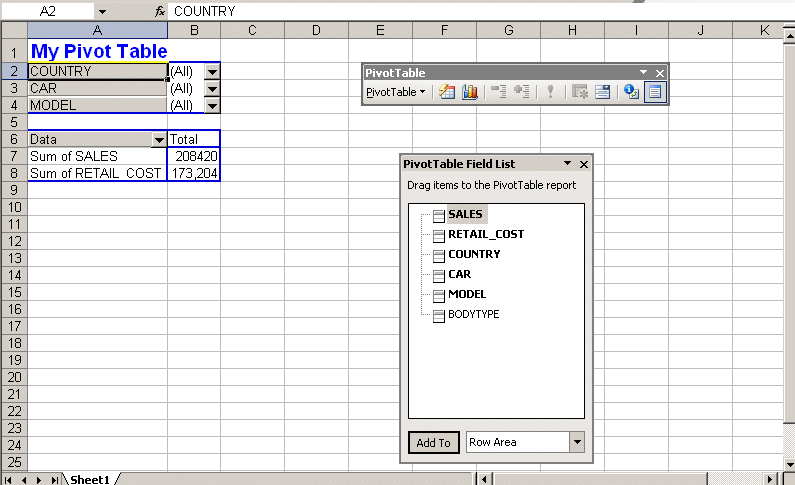
x
Creating EXL2K Reports Using an Excel Template
Excel templates enable users to create WebFOCUS reports
with any new or existing Excel workbook residing on the WebFOCUS
Reporting Server. WebFOCUS can integrate with complex Excel workbooks
containing macros, graphs, or Visual Basic applications with the
use of Excel templates. Users also have access to more advanced Excel
functionality including filters, subtotals, page and print settings,
and advanced report styling.
To create an Excel template, open a new or existing Excel workbook
and designate one worksheet to be replaced with a WebFOCUS report.
The worksheet being replaced must be visible (not hidden). Each
worksheet in the workbook must not be empty (populated with at least
one blank in one cell). A workbook utilizing Excel templates must
be saved as a Single File Web Page (Web Archive) with an extension
of .mht and stored in the Reporting Server application Path (APP
PATH).
After saving, if you do not see the .mht
file extension for the Excel/2000/2003 template file you created,
uncheck the Hide extensions for known file types option
in Windows Folder Options View tab dialog:
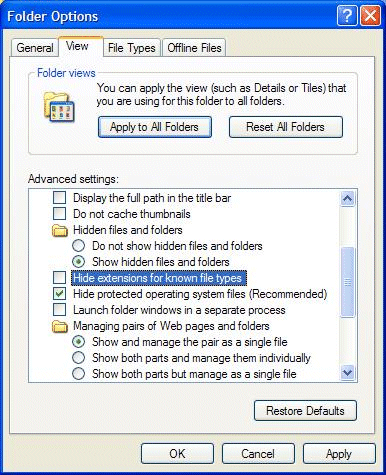
x
Reference: Support for Excel Templates With EXL2K Display Formats
EXL2K
and EXL2K FORMULA are the only formats supported and Excel templates
will only work with Excel 2002 and higher versions.
The following
are not supported with Excel templates: EXL2K PIVOT, EXL2K BYTOC reports,
EXL97, EXCEL, and compound Excel reports.
With EXL2K TEMPLATE
format, WEBARCHIVE is automatically on.
The PCHOLD command
returns an .xmh file, which the mid-tier converts to an .mht. HOLD
creates an .xht file.
x
Syntax: How to Create a Report Using an Excel Template
To
create a report using an Excel template, specify the following:
ON TABLE PCHOLD FORMAT EXL2K TEMPLATE template_name SHEETNUMBER #
where:
- template_name
- The name of the Excel template file (workbook) residing on the
WebFOCUS Reporting Server.
- #
- The number of the Excel worksheet being replaced in the template
file (workbook).
x
Utilizing Excel Named Ranges
An Excel Named Range is a name assigned to a specific
group of cells within an Excel worksheet that can be easily referenced
by WebFOCUS applications. WebFOCUS StyleSheet language facilitates
the generation of Named Ranges.
The use of Excel Named Ranges provides many benefits, including
the following:
- Provides advantages over static cell references, including
the ability of named range data areas to expand to include new data
added during scheduled workbook updates.
- Enables easy setup of Excel worksheets, created by WebFOCUS applications, as an ODBC
(Open Database Connectivity) data source.
- Provides accurate, consistent data feeds to advanced Excel worksheet applications,
which eliminates manual activities that tend to result in errors.
- Simplifies the process of referencing data in multiple worksheets.
This is especially useful when named ranges are added to the output
of an Excel Template report.
x
Syntax: How to Use Excel Named Ranges
To create Excel Named Ranges, use
TYPE=type, IN-RANGES=rangename, $
where:
- type
- Identifies the WebFOCUS report
component to be included in the range. Normally, both of the following
are used together:
DATA adds
the DATA element of the report to the named range (excludes heading,
footing, and column titles).
TITLE adds
the TITLE element of the report to the named range (includes all
column titles).
Note: Multiple elements can be added
to the same named range.
- rangename
- Is the name assigned to the output in the Excel workbook your
application is creating, and is also the name that will be referenced
by other WebFOCUS applications.
Example: Using Excel Named Ranges
This example creates one report in one
worksheet of an Excel workbook. The code specific to Excel Named
Ranges appears in bold in the following syntax.
TABLE FILE GGSALES
PRINT
PRODUCT
DATE
UNITS
BY REGION
BY DOLLARS
ON TABLE SET PAGE-NUM OFF
ON TABLE SET BYDISPLAY ON
ON TABLE NOTOTAL
ON TABLE PCHOLD FORMAT EXL2K
ON TABLE SET STYLE *
UNITS=IN, SQUEEZE=ON, ORIENTATION=PORTRAIT, $
TYPE=REPORT, FONT='ARIAL', SIZE=9, COLOR='BLACK', BACKCOLOR='NONE',
STYLE=NORMAL, $
TYPE=DATA, IN-RANGES='RegionalSales', $
TYPE=TITLE, STYLE=BOLD, IN-RANGES='RegionalSales', $
ENDSTYLE
ENDThe Excel output is:
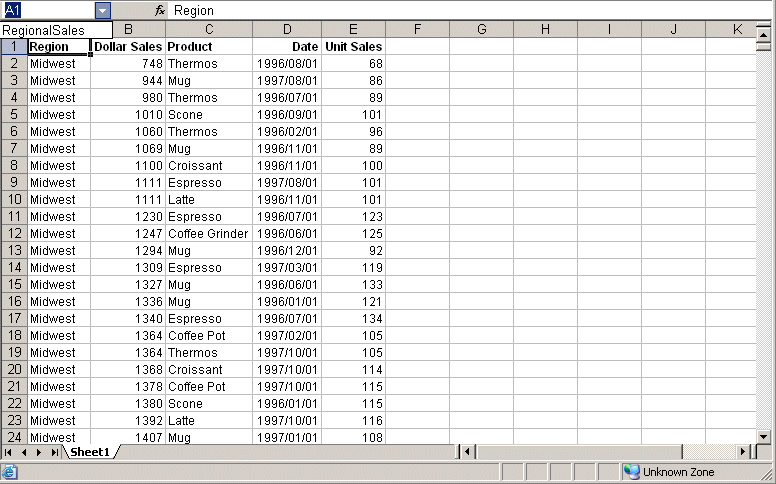
The name assigned to
this Excel Named Range is RegionalSales. If additional rows of data
are added, or columns of data are inserted, the named range will
stretch to contain both new and existing data.
x
Reference: Rules for Excel Named Ranges
- The Excel data area associated with a named range must be continuous
and cannot contain any breaks in the data. Examples of report components
containing breaks in the data that cannot be part of a named range
include SUBHEAD and SUBFOOT.
- It is recommended that you use ON TABLE SET BYDISPLAY ON. This
activates the option to display repeated sort values, which produces
continuous output with no breaks in the data.
- Two different worksheets from the same workbook cannot have
the same range name.
- When creating Compound Excel reports (multiple TABLE requests
output to the same Excel workbook), each report must have a unique
range name that is stored at the workbook level.
x
Reference: Support for Excel Named Ranges
Excel Named
Ranges are supported for the following Excel formats:
EXL2K, EXL2K FORMULA, EXL2K TEMPLATE
Excel Named
Ranges are not supported for the following Excel formats:
EXL2K BYTOC, EXCEL PIVOT
Excel Named Ranges are not supported
with any report syntax that produces discontinuous data or uses
columnar references that span multiple columns, which includes the
following:
ACROSSCOLUMN, RECAP, RECOMPUTE, SUBHEAD, SUBFOOT, SUBTOTAL, SUB-TOTAL
x
Creating Excel Tables of Contents Reports
Excel Table of Contents (TOC) enables you to generate
a multiple worksheet report in which a separate worksheet is generated
for each value of the first BY field in the WebFOCUS
report.
Note: This feature can be used only with Excel 2002 or
higher releases because it requires the Web Archive file format,
which was not available in Excel 2000 and earlier releases.
x
Syntax: How to Use the Excel Table of Contents Feature
The syntax is identical
to that of HTML TOC reports, except that only a single BY field
is allowed in EXL2K, while multiple BY fields are allowed in HTML.
ON TABLE {HOLD|PCHOLD} FORMAT EXL2K BYTOC
Since only one level of TOC is allowed
for EXL2K reports, the optional number following the BYTOC keyword
can only be 1.
As
with HTML, the SET COMPOUND syntax, which precedes the TABLE command,
may also be used to specify that a TOC be created:
SET COMPOUND=BYTOC
Since
a TOC report is burst into worksheets according to the value of
the first BY field in the report, the report must contain at least
one BY field. The bursting field may be a NOPRINT field.
x
Reference: Limitations of TOC Reports
- A TOC report cannot be embedded in a compound report.
- A TOC report cannot be a pivot table report.
- A TOC report can not be generated against a multi-verb request.
Note: FORMULA is not supported with
bursting.
Example: Creating a Simple TOC Report
The following request against the GGSALES
data source creates separate tabs based on the REGION sort field:
TABLE FILE GGSALES
SUM UNITS/D12C DOLLARS/D12CM
BY REGION NOPRINT
BY CATEGORY
BY PRODUCT
HEADING
"<REGION Region Sales"
ON TABLE PCHOLD FORMAT EXL07
ON TABLE SET BYDISPLAY ON
ON TABLE SET COMPOUND BYTOC
ON TABLE SET STYLE *
TYPE=REPORT, FONT=ARIAL,SIZE=9,$
TYPE=HEADING, SIZE=12,$
TYPE=TITLE, BACKCOLOR=GREY,COLOR=WHITE, $
ENDSTYLE
END
The output is:
x
Reference: How to Name Worksheets
- The worksheet tab names are the BY field
values that correspond to the data on the current worksheet. If
the user specifies the TITLETEXT keyword in the stylesheet, it will
be ignored.
- Excel limits the length of worksheet
titles to 31 characters. The following special characters cannot
be used: ':', '?', '*', and '/'.
- If you want to use date fields as the bursting BY field, you
can include the - character instead of the / character. The - character
is valid in an Excel tab title. However, if you do use the / character, WebFOCUS will substitute it with the
- character.
x
Naming EXL2K Worksheets with Case Sensitive Data
The BYTOC option of WebFOCUS
EXL2K format generates a workbook containing an individual worksheet
for each primary sort (BY) field in the report. Each sheet is named
with the value of the primary sort field to identify the data it
contains.
Excel requires each sheet name to be unique. Excel is case insensitive
meaning it evaluates two values as being the same when the values
contain the same characters but have different casing. For example,
Excel evaluates the values COFFEE and Coffee to be the same value
and, therefore, they cannot be used as sheet names for two different sheets.
By default, WebFOCUS sort processing
is case sensitive, so the same field value with different casing
is considered to be two different values when used as a sort (BY) field.
In an Excel BYTOC report, WebFOCUS
will generate sheets with sheet names for each value of the primary
sort (BY) key based on case sensitivity. For sort values that differ
in casing only, the initial sheet will receive the sort value, and
Excel will have difficulty with any subsequent sheet generated with
the same name. The second sheet name will display as Recovered_Sheet1 in
place of the value Excel considers a duplicate.
Example: Using Case Sensitive Data in an EXL2K TOC Report
In the following example, WebFOCUS will generate separate worksheets for
the values Coffee and COFFEE. The initial worksheet will be named
COFFEE, but for the subsequent worksheet representing the value Coffee,
Excel will be unable to use the value as the worksheet name and
will display the recovered value.
DEFINE FILE GGSALES
SHOWCAT/A15=IF PRODUCT EQ 'Espresso' THEN 'COFFEE' ELSE CATEGORY;
END
TABLE FILE GGSALES
BY SHOWCAT
BY PRODUCT
ON TABLE SET PAGE-NUM OFF
ON TABLE PCHOLD FORMAT EXL2K
ON TABLE SET COMPOUND 'BYTOC 1'
END
On the output, the second
tab has the name Recovered_Sheet1 instead
of the case sensitive value Coffee:

x
Reference: Using Case Sensitive Data as Worksheet Names
When
you know your data contains values with case sensitive differences
in the highest level sort field, you will need to massage your data
values so that they can be used as valid sheet names in the BYTOC
workbook.
Different approaches include:
- Converting your values to a single case so that they group together
in WebFOCUS as they do in Excel. You
can control the collation sequence with the SET COLLATION=SRV_CI
command described in Controlling Collation Sequence.
- Adding a unique sequence number to your high level sort field
values so that they continue to create different tabs but the sheet
name values remain unique
Example: Creating Unique Case Sensitive Sheet Names
In the following example, the sheet
name is built by adding a unique counter to each unique value of
the high level sort field. The new computed field is then used as
the first BY field in the request, so it is used by the BYTOC phrase
to define the sheet names. The sheet name field can be presented
within the report or specified as a NOPRINT field so that it displays
on the tab but does not display on the actual report:
DEFINE FILE GGSALES
SHOWCAT/A15=IF PRODUCT EQ 'Espresso' THEN 'COFFEE' ELSE CATEGORY;
END
TABLE FILE GGSALES
PRINT SHOWCAT NOPRINT
COMPUTE CNTR/I2 = IF SHOWCAT EQ LAST SHOWCAT THEN LAST CNTR ELSE CNTR + 1; NOPRINT
BY TOTAL COMPUTE SHOWCAT2/A20 = EDIT(CNTR) | '-' | SHOWCAT; NOPRINT
BY SHOWCAT
BY PRODUCT
ON TABLE SET PAGE-NUM OFF
ON TABLE PCHOLD FORMAT EXL2K
ON TABLE SET COMPOUND BYTOC
ON TABLE SET STYLE *
GRID=OFF, $
ENDSTYLE
END
On the output, each tab
has a name consisting of a sequence number followed by the sort
field value with its correct case:
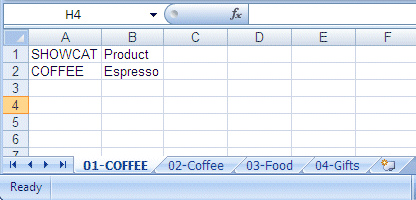
x
Overcoming the Excel 2003 65K Row Limit Using Overflow Worksheets
The maximum number of rows supported by Excel 2003 on
a Worksheet is 65,536 (65K). When you create an EXL2K output file
from a WebFOCUS report, the number
of rows generated can be greater than this maximum.
To avoid creating an incomplete output file, you can have extra
rows flow onto a new Worksheet, called an overflow Worksheet.
The name of each overflow Worksheet will be the name of the original
Worksheet appended with an increment number.
In addition, when the overflow Worksheet feature is enabled,
you can set a target value for the maximum number of rows to be
included on a Worksheet. By default, the row limit will be set to
the default value for the LINES parameter (57).
Note: When generating EXL2K output, the WebFOCUS page heading and page footing
commands generate Worksheet headings and Worksheet footings.
x
Syntax: How to Enable Overflow Worksheets
Add the ROWOVERFLOW=ON attribute to
your WebFOCUS StyleSheet
TYPE=REPORT, ROWOVERFLOW=ON, ...
This
attribute will work only with EXL2K output, which generates web
archive files (.XHT). For all other output types, the ROWOVERFLOW
StyleSheet attribute is ignored, and data flow is not affected.
x
Syntax: How to Set a Target Number of Rows for an EXL2K Worksheet
The
ROWOVERFLOW=ON attribute is required in the WebFOCUS
StyleSheet in order to set a target number of rows for the Worksheets
in the EXL2K output file.
In a FOCEXEC
or profile, use the following syntax
SET LINES = nnnnn
In a request, use the following syntax
ON TABLE SET LINES nnnnn
where:
- nnnnn
- Is a target value for the maximum number of lines to be included
on any Worksheet in the EXL2K output file when the overflow Worksheet
feature is enabled. The value must be less than 65K. Each Worksheet
will end within a range of the designated limit. The actual row
count for each sheet is calculated individually based on user defined
heading/footing lines and other system generated lines added to
each sheet by the specific report request. If necessary, you can
modify how your report flows across Worksheets by adding or removing
space in subheadings and/or subfootings.
x
Reference: Usage Notes for Excel 2003 Overflow Worksheets
Example: Creating Overflow Worksheets With EXL2K Report Output
The following request creates EXL2K
report output with overflow Worksheets. The SET LINES command sets
the maximum number of rows in each Worksheet to approximately 2000,
and the ROWOVERFLOW=ON attribute in the StyleSheet activates the
overflow feature. Without this attribute, one Worksheet would have
been generated instead of three:
TABLE FILE GGSALES
-* ****Report Heading****
ON TABLE SUBHEAD
"SALES BY REGION, CATEGORY, AND PRODUCT"
" "
-* ****Worksheet Heading****
HEADING
"SALES REPORT WORKSHEET <TABPAGENO"
" "
-* ****Worksheet Footing****
FOOTING
" "
"END OF WORKSHEET <TABPAGENO"
PRINT DOLLARS UNITS BUDDOLLARS BUDUNITS
BY REGION
BY CATEGORY
BY PRODUCT
BY DATE
-* ****Subfoot****
ON REGION SUBFOOT
" "
" End of Region <REGION"
" "
-* ****Subhead****
ON CATEGORY SUBHEAD
" "
" Category <CATEGORY for Region <REGION"
" "
-* ****Report Footing****
ON TABLE SUBFOOT
" "
"END OF REPORT"
ON TABLE SET LINES 2000
ON TABLE PCHOLD FORMAT EXL2K
ON TABLE SET STYLE *
TYPE=REPORT, TITLETEXT=EXLOVER, ROWOVERFLOW=ON,$
ENDSTYLE
END
The report heading displays
on the first Worksheet only, the page heading and column titles
display on each Worksheet, and the subhead and subfoot display whenever
the associated sort field changes value. The following image shows
the top of the first Worksheet, displaying the report heading, page
heading, column titles, and first subhead:
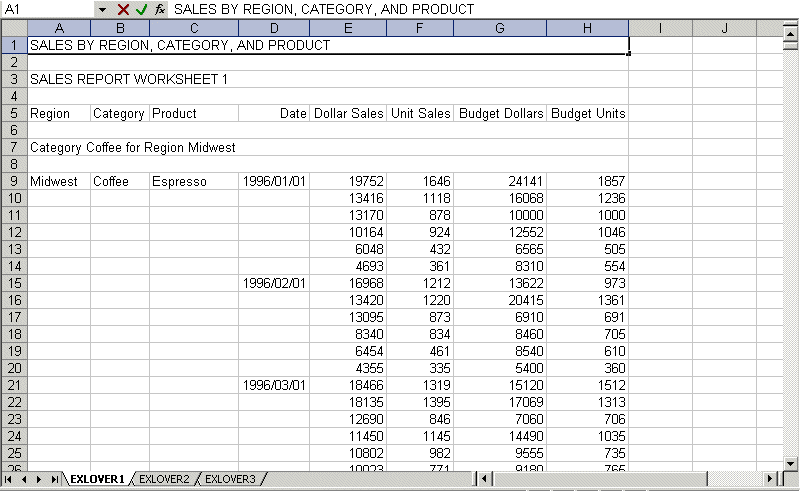
Note that the TITLETEXT
attribute in the StyleSheet specified the name EXLOVER, so the three
Worksheets were generated with the names EXLOVER1, EXLOVER2, and EXLOVER3.
If there had been no TITLETEXT attribute, the sheets would have
been named SHEET1, SHEET2, and SHEET3.
The
Worksheet footing displays at the bottom of each Worksheet and the
report footing displays at the bottom of the last Worksheet. The
following image shows the bottom of the last Worksheet, displaying
the last subfoot, the page footing and the report footing:
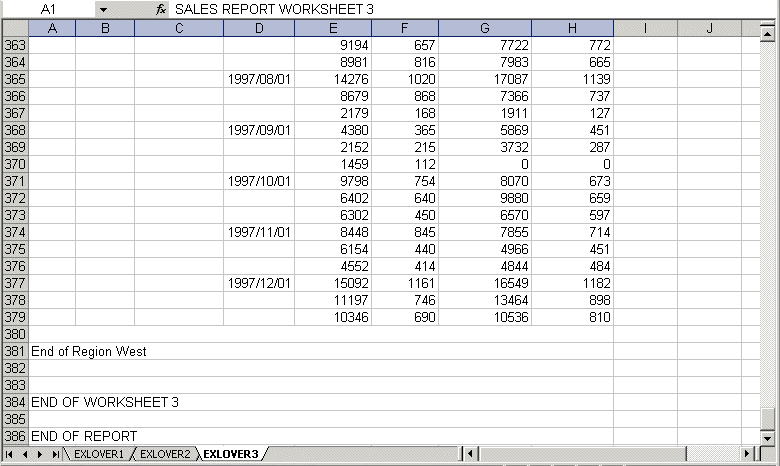
x
Providing a Tooltip on a Drilldown Hyperlink for EXL2K Reports
You can use the ALT attribute in a StyleSheet for EXL2K
report output to provide informational text (a tooltip) for a drilldown
hyperlink.
x
Syntax: How to Provide a ToolTip for a Drilldown Hyperlink
For a drilldown hyperlink to a FOCEXEC:
TYPE=type, [subtype], FOCEXEC=fex[(parameters ...)], [TARGET=frame,]
[ALT='tooltip_text',] $
For a drilldown hyperlink to a URL:
TYPE=type, [subtype], URL=url[(parameters ...)], [TARGET=frame,] [ALT='tooltip_text',] $
where:
- type
- Identifies the report component that you select in the Web browser
to execute the link. The TYPE attribute and its value must appear
at the beginning of the declaration.
- subtype
- Are any additional attributes, such as COLUMN, LINE, or ITEM,
that are needed to identify the report component that you are formatting.
- fex
- Identifies the file name of the linked procedure to run when
you select the report component.
- url
- Identifies any valid URL, including a URL that specifies a WebFOCUS
Servlet program, or the name of a report column enclosed in parentheses
whose value is a valid URL to which the link will jump.
- parameters
- Values that are passed to the report or URL.
- frame
- Identifies the target frame in the Web page in which the output
from the drill-down link is displayed.
- tooltip_text
- Is the informational text to display when the mouse hovers over
the hyperlink.
x
Reference: Usage Notes for Drilldown Hyperlinks With EXL2K Report Output
The
JAVASCRIPT and IMAGE drilldown options are not supported with format
EXL2K.
Example: Providing a Tooltip for a Drilldown Link in a Footing
The following report request summarizes
product sales and sorts the data by region, state, and store code.
The store code also displays in the subfootings where links display to
detailed reports about the sales for the store (by product or by
date). Each line of the subfoot contains two text objects and one
embedded field.
TABLE FILE GGSALES
HEADING
"Sales Report"
SUM DOLLARS/I08M
BY REGION BY ST BY STCD
ON STCD SUBFOOT
"View Store <STCD Sales By Product"
" "
"View Store <STCD Sales By Date"
ON TABLE PCHOLD FORMAT EXL2K
ON REGION PAGE-BREAK
ON TABLE SET PAGE-NUM OFF
ON TABLE SET STYLE *
TYPE=HEADING, SIZE=12, STYLE=BOLD, $
TYPE=SUBFOOT, LINE=1, OBJECT=TEXT, ITEM=2,
FOCEXEC=PRDSALES(STOREID=STCD), ALT='Product Sales',$
TYPE=SUBFOOT, LINE=3, OBJECT=TEXT, ITEM=2,
FOCEXEC=HSTSALES(STOREID=STCD),ALT='Sales History', $
ENDSTYLE
END
Using StyleSheet declarations, the subfoot phrase Sales
By Product links to a second procedure named PRDSALES and passes
it the value of STCD displayed in the subfoot. The subfoot phrase Sales By Date links
to a procedure named HSTSALES and passes it the value of STCD displayed
in the subfoot. The ALT attributes in the StyleSheet declarations
for the hyperlinks provide informational messages.
The linked PRDSALES report follows:
TABLE FILE GGSALES
SUM UNITS
BY STCD
BY PRODUCT
WHERE STCD = '&STOREID'
ON TABLE SET PAGE-NUM OFF
ON TABLE PCHOLD FORMAT EXL2K
ON TABLE SET STYLE *
TYPE=REPORT, GRID=OFF, $
ENDSTYLE
END
The linked HSTSALES report
follows:
TABLE FILE GGSALES
SUM UNITS
BY STCD
BY DATE
WHERE STCD = '&STOREID'
ON TABLE SET PAGE-NUM OFF
ON TABLE PCHOLD FORMAT EXL2K
ON TABLE SET STYLE *
TYPE=REPORT, GRID=OFF, $
ENDSTYLE
END
The first page of output
for the main report follows. If your mouse hovers over the Sales By
Date link, the informational text Sales History displays:
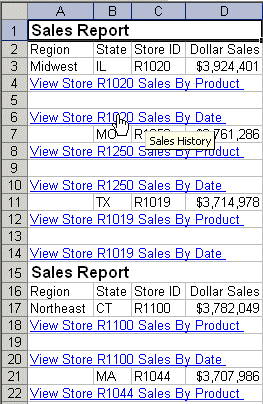
x
Embedding a WebFOCUS Report in an Excel 2000/2003 Workbook
Using an optional feature of
Excel called Microsoft Web Query, you can embed a WebFOCUS report
in a customized Excel worksheet that already contains styling, formulas,
and macros.
Note: You can also embed a WebFOCUS report in an Excel
workbook using WebFOCUS Quick Data. WebFOCUS Quick Data is a Microsoft
Office Add-in that enables you to connect Microsoft Excel directly
to WebFOCUS reporting tools where you can access and analyze all
of your enterprise data. For information about installing and using
WebFOCUS Quick Data, see TM4693: Using the WebFOCUS Quick
Data Add-In.
Microsoft Web Query uses a URL to embed external data or an HTML
page into the worksheet. Since you can easily construct a URL that
calls the WebFOCUS engine, you can use this URL as the source of
your query. Then, instead of following the typical reporting path
in which you execute a request from the browser and display the
output in an Excel worksheet that conforms to the formatting of
the report request, you can execute a request that returns HTML
from a query inside an existing Excel worksheet whose content and
layout you can control in Excel. Said another way, instead of having
WebFOCUS push the report into the worksheet, you can have Excel
pull the report into the worksheet. This "pull" technique supports
the delivery of real time data directly into your own customized worksheets.
The process has two parts:
- Create the WebFOCUS report, if you have not already done
so.
- Designate the area in your worksheet into which Microsoft Web
Query will pull the report, and provide Query with specifications
for locating and embedding it.
You must have a web browser installed on your PC to take advantage
of this technique.
The following is a customized worksheet that was created using
this technique. Notice that it includes logos (images), a report,
formulas, and an Excel graph. There are two formulas added outside
of the query range that sum and average the data brought back by the
query. The report is generated as the result of a web query in the
area of the worksheet that has been designated to contain it. The
graph is also based on the results of this query. Each time the
query is refreshed, the formulas and the graph update as well.
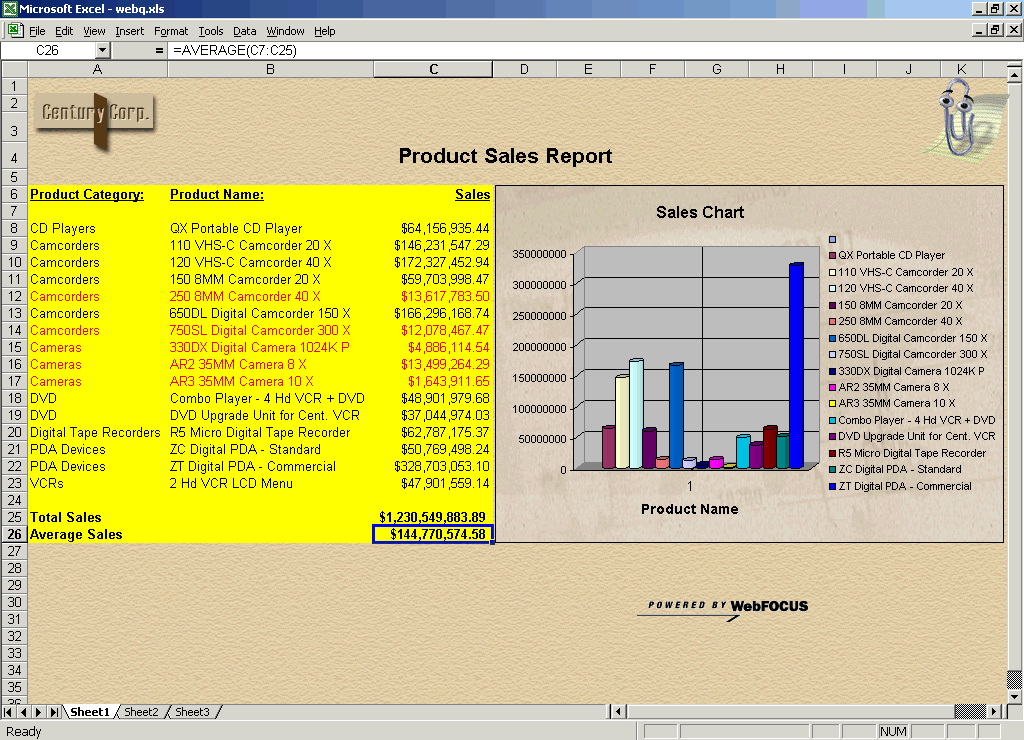
After you understand the rudiments of this technique, you will
be able to adapt it to suit your preferred way of working with Excel.
For example, you can:
- Pull a WebFOCUS report into an Excel worksheet that you
have already customized with logos (images), a report, formulas,
or an Excel graph.
or
- Open a blank worksheet, pull in a WebFOCUS report, and then
customize the worksheet as you like.
You can implement this technique, with some variations, in Excel
2000/2003 and Excel 97. For illustrations, see Embedding a WebFOCUS Report in an Excel 2000/2003 Workbook and Embedding a WebFOCUS Report in an Excel 97 Spreadsheet. For details
on how to set up a web query in Excel 2000 or Excel 97, see your
Microsoft Excel documentation.
Note: Microsoft Web Query may not have been installed
by default. If you have not already installed it, you will be prompted
to install Web Query the first time you attempt to access the feature.
Just follow the install instructions provided.
Example: Embedding a WebFOCUS Report in a Customized Excel 2000/2003 Worksheet
This
example creates the HTML report, then uses Web Query to set up the
customized worksheet to receive it.
Step 1: Create the WebFOCUS report
Create
and save the following request, webq.fex, which you will embed in
a customized Excel 2000/2003 worksheet: The numbers to the left
of each line of code correspond to annotations that follow the request.
1. TABLE FILE CENTORD
2. SUM LINEPRICE AS 'Sales'
3. BY PRODCAT
4. BY PRODNAME
5. ON TABLE PCHOLD FORMAT HTML
6. ON TABLE SET HTMLCSS ON
7. ON TABLE SET BYDISPLAY ON
8. ON TABLE SET PAGE-NUM TOP
9. ON TABLE SET STYLESHEET *
10. TYPE=REPORT, FONT=ARIAL, GRID=OFF, BACKCOLOR=YELLOW, $
11. TYPE=TITLE, STYLE=BOLD, $
12. TYPE=DATA, COLOR=RED, WHEN=LINEPRICE LT 15000000, $
13. ENDSTYLE
14. END
Line 1 identifies the sample data
source, CENTORD, which contains sales data for the Century corporation.
Lines 2-4 define
display and sorting requirements for the report.
Lines 5-6 define
the output format as HTML and turn on Cascading Style Sheets, a
feature that increases the efficiency and overall styling capabilities
of HTML.
Important: The report must be in HTML format
and not EXL2K. This is because Web Query imports fully formatted
HTML pages or individual HTML tables into a worksheet. Executing
an EXL2K request from a query will not return any data to the worksheet.
Line 7 sets
BYDISPLAY to ON. This optional setting ensures that repeated sort
values in the report are populated with data.
By default,
repeated sort values in vertical columns (or BY fields) are suppressed
in a WebFOCUS report, leaving blank fields in the report. This behavior
is not desirable for Excel reports, which are designed to work with
data that is repeated in every row to which it applies. A blank
column or row can produce misleading results when sorting data.
Line 8 turns
off page numbering and removes any extra lines generated above the
column titles.
Lines 9-13 specify styling attributes
for the report: background color, conditional styling, and some
other miscellaneous styling have been designated. Styling, including
drill-downs, carry over into Excel.
Step 2: Designate the area in the worksheet into which Web Query will pull the report
In
your worksheet, you designate the area where you want your WebFOCUS
report to be displayed. You can designate a cell and let Excel determine
how much space to allot to the report or you can specify a range
of cells to limit the placement. For some techniques that may help
you evaluate and control space requirements, see Tips for Populating Excel Worksheets With WebFOCUS Reports.
- Open a worksheet and highlight the cell or range.
- From the Data menu, select Get External Data,
then select New Web Query.
The New Web
Query dialog box opens.
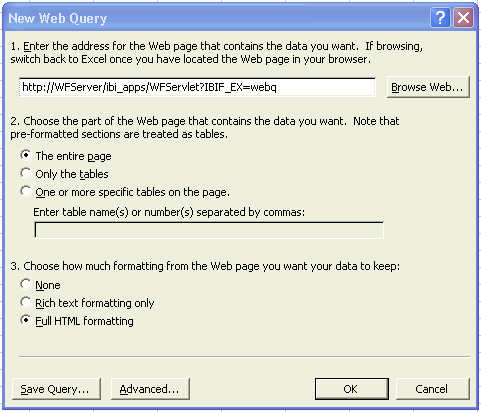
- In this dialog box:
- Specify a URL that points to the
WebFOCUS server. The URL needs to be constructed as a call to the
WebFOCUS Servlet and contain any appropriate parameters that need
to be passed.
In the illustration, the code
http://servername/ibi_apps/WFServlet?IBIF_ex=webq
calls
the WebFOCUS Servlet and requests the procedure called webq.fex.
This is the report created in Step 1.
Keep in mind that you
may also need to pass a user ID and password to get to a secure
server. You must add parameters to the query manually. To do this,
save the query as an .iqy file and manually add parameters to the
URL request. For details, see How to Create a Web Query (IQY) File.
- Specify whether the entire page or only the tables should be
extracted from the requested file. In this example, select the entire
page.
Since WebFOCUS HTML reports are generated using HTML tables,
you can select either The entire page or Only
the tables. (At the present time, you cannot identify
individual tables in a WebFOCUS HTML report.)
- Select Full HTML formatting to ensure
that all styling transfers to the worksheet. This step is important
if you want a styled report to be carried over to Excel.
- Click OK.
The Returning External
Data dialog box opens.
- Indicate the range of cells into which you want the data to
be returned in your worksheet.
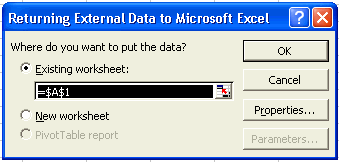
- Click the Properties button in the Returning
External Data dialog box. The External Data Range Properties dialog
box opens.
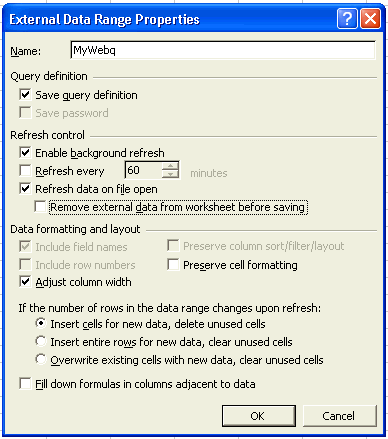
Name the query and
set its refresh behavior. For example, you can set the query to
automatically refresh every time the worksheet opens. (Note that
you can also set these properties after the initial execution.)
Click OK to
run the web query. The report is pulled into the area of the worksheet
that has been designated to contain it.
- Save the worksheet with the embedded query. (Note that if you
click the Save Query button, the query information
will be saved as an .iqy file that you can use again with other
worksheets.)
- After the query is created and executed, you can customize your
worksheet as much as you like.
Note: You only
need to run Web Query once to embed a query in a worksheet. After
it is executed, the static data stays in the worksheet as a placeholder
for the query. However, as long as you are connected to your network,
the internet, or whatever other connection mechanism is in affect
for your application, when you open your local worksheet, WebFOCUS
delivers the latest information directly into your own customized
worksheet. You can also click the Refresh Data option
at anytime to update the information.
If you wish to delete
a query, delete all the query data in the worksheet.
For an
illustration of a customized worksheet that contains the report
created in step 1, see Embedding a WebFOCUS Report in an Excel 2000/2003 Workbook. The worksheet
includes logos (images), a report, formulas, and an Excel graph.
The graph is also based on the results of this query. Each time
the query is refreshed, the formulas and the graph update as well.
x
Reference: Tips for Populating Excel Worksheets With WebFOCUS Reports
In
addition to the method described in the example Embedding a WebFOCUS Report in an Excel 2000/2003 Workbook, you can employ
other techniques to take advantage of Web Query in your worksheet.
For example, if you have an existing worksheet with a lot of pre-defined
elements, you may need to run the query in a separate worksheet
and see how much space it will take up before adding it to the main
"working area" of the worksheet. It is a good idea to designate
one particular worksheet for your query and have everything else
refer to the data via formulas on another worksheet.
Another approach
is to include everything in the same worksheet. Other surrounding elements
in the worksheet should automatically reposition when the data comes
back, but you may want to leave a buffer area around the query to
ensure sufficient space for the report output.
xViewing a Report in EXL97 Format
In this section: Reference: |
The EXL97 format allows you to view reports in Excel
97, which supports full styling and drill-down
capability.
When you specify EXL97 format, an HTML-based
file is generated with an extension of .e97. The appropriate MIME
type is automatically assigned to designate Excel as the active application
for this file type.
When using the Microsoft Internet Explorer
browser and Excel 97, the Excel client opens in the background and
the report launches in your browser. You may see the Excel application
open and minimize while viewing your report; leave Excel open when
viewing the spreadsheet.
After the report is generated, you can save
the document as an Excel spreadsheet locally on your PC. In Excel
97, you will be prompted to save the document as a Microsoft Excel
Workbook with an .xls extension. This will save the file as a binary
Excel document.
WebFOCUS can also run directly from Excel
without using a browser by creating a hyperlink within Excel that
calls the WebFOCUS client with the necessary parameters. For details,
see Embedding a WebFOCUS Report in an Excel 2000/2003 Workbook.
Format EXL97 is fully compatible with Excel 2000, Excel 2002,
and Excel 2003.
Note: Although format EXL97 is available, there are some
limitations when compared to the EXL2K formats. See Limitations for FORMAT EXL97. Future enhancements in the area of Excel
integration will primarily be made to the EXL2K and EXL07 formats.
We recommend upgrading to Excel 2003 or higher so you can take full advantage
of our Excel integration, as well as all future enhancements.
Example: Viewing a Report in EXL97 Format
The
following example illustrates how a report displays when using PCHOLD
FORMAT EXL97. The request includes drill-downs to another procedure
and formatting options, including conditional styling.
TABLE FILE CENTORD
HEADING
"Order Revenue"
"Styled Report in Excel 97"
" "
SUM ORDER_DATE LINEPRICE AS 'Order,Total:'
BY HIGHEST 10 ORDER_NUM
ON TABLE SET PAGE-NUM OFF
ON TABLE SET ACCESSIBLE 508
ON TABLE PCHOLD FORMAT EXL97
ON TABLE SET STYLE *
TYPE=HEADING, COLOR=NAVY, SIZE=14, $
TYPE=HEADING, LINE=2, COLOR=RED, $
TYPE=DATA, BACKCOLOR=AQUA, STYLE=BOLD, WHEN=LINEPRICE GT 200000, $
TYPE=TITLE, STYLE=BOLD, $
TYPE=DATA, COLUMN=ORDER_NUM, FOCEXEC=DETAILS, $
END
The output is:
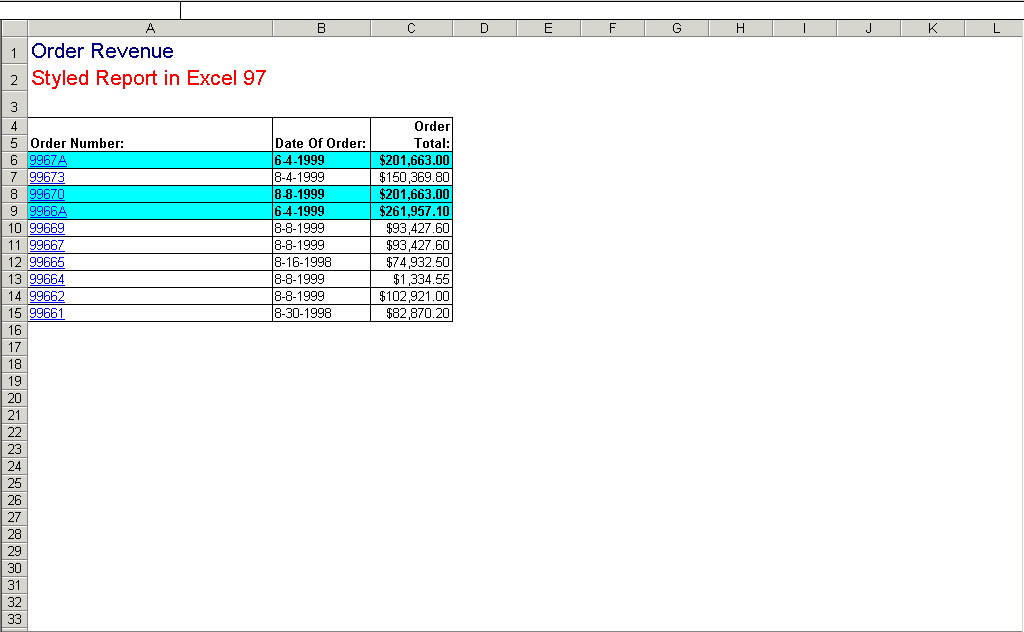
x
Reference: Limitations for FORMAT EXL97
- This format is only compatible with Excel 97 or higher. This
format is not compatible with Excel 95 or any versions of Excel
prior to Excel 95.
- Excel 97 does not support Cascading Style Sheets (CSS). Any
styling specified in a report that uses CSS (SET HTMLCSS=ON) will
not be respected in Excel 97. The WRAP=n feature is not supported
with EXL97 since this feature requires CSS.
-
WebFOCUS uses nested HTML tables
when generating a heading, which may cause a problem in EXL97. As
an alternative, specify HEADALIGN=BODY in your StyleSheets for all
HEADING objects including FOOTING, SUBHEAD, and SUBFOOT commands.
This creates the heading as a separate table.
- Page numbers display by default and are placed in the heading.
We recommend that you turn page numbering off (SET PAGE-NUM=OFF).
- All numeric and date formatting options that are not supported
for EXL2K are also not supported for EXL97. In addition, negative
numbers displayed with brackets, trailing zeroes after the decimal,
and leading zeros will not display with EXL97 reports. Note that dates
are typically translated into Excel's General format, which can
cause problems with sorting and other Excel features.
- PivotTables are not supported with EXL97.
x
Embedding a WebFOCUS Report in an Excel 97 Spreadsheet
WebFOCUS can integrate with Excel 97 to give you a completely customizable
spreadsheet with styling, drill-downs, and formulas.
In an effort to integrate Microsoft Excel with the web, Microsoft
introduced a host of new capabilities in Excel 97, including the
ability to import HTML directly into Excel spreadsheets with formulas,
styling, and AutoFilters. In addition, Excel 97 offers an optional feature
of Excel, Web Query, which enables users to query specific web pages
or servers in order to pull live data from the web into their spreadsheets
while maintaining worksheet layout and formulas. A query can be
set to automatically refresh and even prompt the user for parameters.
In Excel 97, web queries are text files that are created in an
editor and saved in the appropriate directory with the extension
.iqy. (Unlike Excel 2000/2003, there is no graphical environment
in which to create queries. For details, see Embedding a WebFOCUS Report in an Excel 97 Spreadsheet.)
A web query consists of three or four lines of text separated
by carriage returns. The IQY file is only needed the first time
a query is executed to establish the data location and parameters.
After a query is run inside a spreadsheet and the spreadsheet is
saved, the query information is always present and can be refreshed
at any time.
The process of embedding a WebFOCUS report into an Excel 97 spreadsheet
has three parts:
- Create the WebFOCUS report.
- Create the Web Query file.
- Run the Web Query utility to pull the report into the spreadsheet.
x
Syntax: How to Create a Web Query (IQY) File
An
IQY file is constructed as follows
Type_of_query [CR]
Version_of_query [CR]
URL [CR]
{POST|GET} parameters [CR]where:
- Type_of_query
- Is Web. Since Web is the default value, this is an optional
entry.
- Version_of_query
- Is the current version of the Web Query software. 1 is the default
value. This entry is optional.
- URL
- Is a required entry that points to the WebFOCUS server. The
URL needs to be constructed as a call to the WebFOCUS Servlet and
contain any appropriate parameters that need to be passed.
- POST parameters
- Is the preferred method of retrieving large amounts of data
and sending it data back as a separate line of text. For example:
http://WFserver/ibi_apps/WFServlet[CR]
PARAM1=value & PARAM2=value
- GET parameters
- Is the preferred method of retrieving smaller amounts of data
and appending the data to the URL. For example:
http://server/ibi_apps/WFServlet?PARAM1=value&PARAM2=value
- [CR]
- Designates required carriage returns.
Example: Embedding a WebFOCUS Report in an Excel 97 Spreadsheet
Step 1: Create the WebFOCUS Report
Create
and save the following fully styled WebFOCUS report as webq97. You
will embed this report in an Excel 97 spreadsheet. (For proper styling
and execution of the request in Excel 97, ensure that Cascading
Style Sheets are not in effect; SET HTMLCSS=OFF is the default value.)
The
numbers to the left of each line of code correspond to annotations
that follow the request.
1. TABLE FILE CENTORD
2. SUM LINEPRICE AS 'Sales'
3. BY YEAR AS 'Year'
4. BY PRODCAT AS 'Category'
5. BY PRODNAME AS 'Product'
6. WHERE YEAR EQ '&YEAR';
7. ON TABLE SET BYDISPLAY ON
8. ON TABLE PCHOLD FORMAT HTML
9. ON TABLE SET PAGE-NUM TOP
10. ON TABLE SET STYLE *
11. TYPE=REPORT, FONT=ARIAL, SIZE=10, GRID=OFF, BACKCOLOR=YELLOW, $
12. TYPE=TITLE, SIZE=11, STYLE=BOLD, $
13. TYPE=DATA, COLOR=RED, WHEN=LINEPRICE LT 15000000, $
14. TYPE=DATA, COLUMN=PRODCAT, FOCEXEC=webq2(PRODCAT=N1), $
15. ENDSTYLE
16. END
Line 1 identifies the sample data
source, CENTORD, which contains sales data for the Century Corporation.
Lines 2-5 define
display and sorting requirements for the report.
Line 6 specifies
selection criteria using a variable, &YEAR.
Line 7 sets
BYDISPLAY to ON. This setting ensures that repeated sort values in
the report are populated with data.
By default, repeated sort
values in vertical columns (or BY fields) are suppressed in a WebFOCUS
report, leaving blank fields in the report. This behavior is not
desirable for Excel reports, which are designed to work with data
that is repeated in every row to which it applies. A blank column
or row can produce misleading results when sorting data.
Lines 8 defines
the output format as HTML.
Important: The report must
be in HTML format and not EXL97. This is because Microsoft Query
imports fully formatted HTML pages or individual HTML tables into a
spreadsheet. Executing an EXL97 request from a query will not return
any data to the spreadsheet.
Line 9 turns off page
numbering and removes any extra lines generated above the column
titles.
Lines 10-15 specify styling attributes for
the report: background color, conditional styling, a drill-down
to another procedure, and some other miscellaneous styling have
been designated. Styling, including drill-downs, carries over into
Excel.
Step 2: Create a Web Query (IQY) File
Open
a text editor and create the following web query file
1. WEB
2. 1
3. http://WFserver/ibi_apps/WFServlet?IBIF_ex=webq97
&YEAR=["YEAR","Select Year"]where:
Line 1 identifies
this as a Web query.
Line 2 identifies the current
version of Microsoft Query.
Line 3 is a typical WebFOCUS
request using the GET method. The name of the procedure is webq97.
The URL line passes a parameter of YEAR into the procedure. The user
will be prompted to supply a value for YEAR. Of course, passing
parameters is optional. In the example above, we have a dynamic
parameter, but the parameters can be static as well. In other words,
hard coded in the IQY file.
Note that carriage returns are
required between lines in this file.
After you have constructed
the query, save the document with an .iqy extension in the Queries
directory under Microsoft Office. For example,
<drive>:\Program Files\Microsoft Office\Queries\webq97.iqy
Now
that the IQY file is ready, you can create the spreadsheet and embed
the query.
Step 3: Embed the Query in an Excel 97 Spreadsheet
This
example starts with a blank spreadsheet, embeds the query, and then
adds the bells and whistles.
- Open a blank spreadsheet.
From the Data menu, select Get External Data, followed by Run Web
Query. The Run Query dialog box opens.
- Locate the IQY file, webq97.icy, and click the Get
Data button. The Run Query dialog box opens.
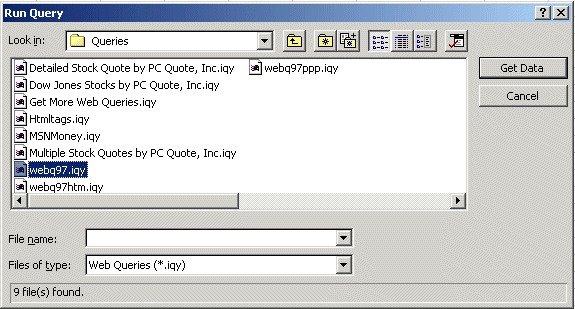
- Specify where the data will go in your spreadsheet. You can
choose a range in the current spreadsheet or you can choose to put
the data into a new worksheet. In this case, specify the range as
indicated:
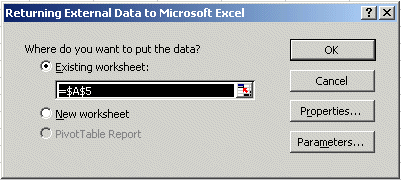
There is no need to
set the range in the case of a blank worksheet, however, you may
want to output the data in a new worksheet and use formula references
to work with the data.
- Click the Properties button in the Returning
External Data dialog box. The External Data Range Properties dialog
box opens. Name the query and set its behavior. For example, you
can set the query to automatically refresh every time the worksheet
opens. (Note that you can also set these properties after the initial execution.)

Click OK.
- Click the Parameters button
in the Returning External Data dialog box to define the behavior
for any parameters you may have in your query. You can prompt the
user, set a static value, or use a value from a cell in the worksheet.
In this example, you will prompt the user for the YEAR.
Enter
the value 1999.
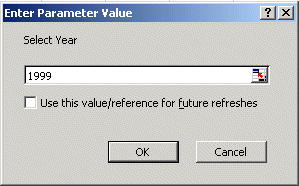
- After you select the range and set all of the query properties,
click the OK button.
The query executes
and imports the data. The following message is displayed in the
spreadsheet:
webq97: Getting Data...
The
data appears in the spreadsheet:
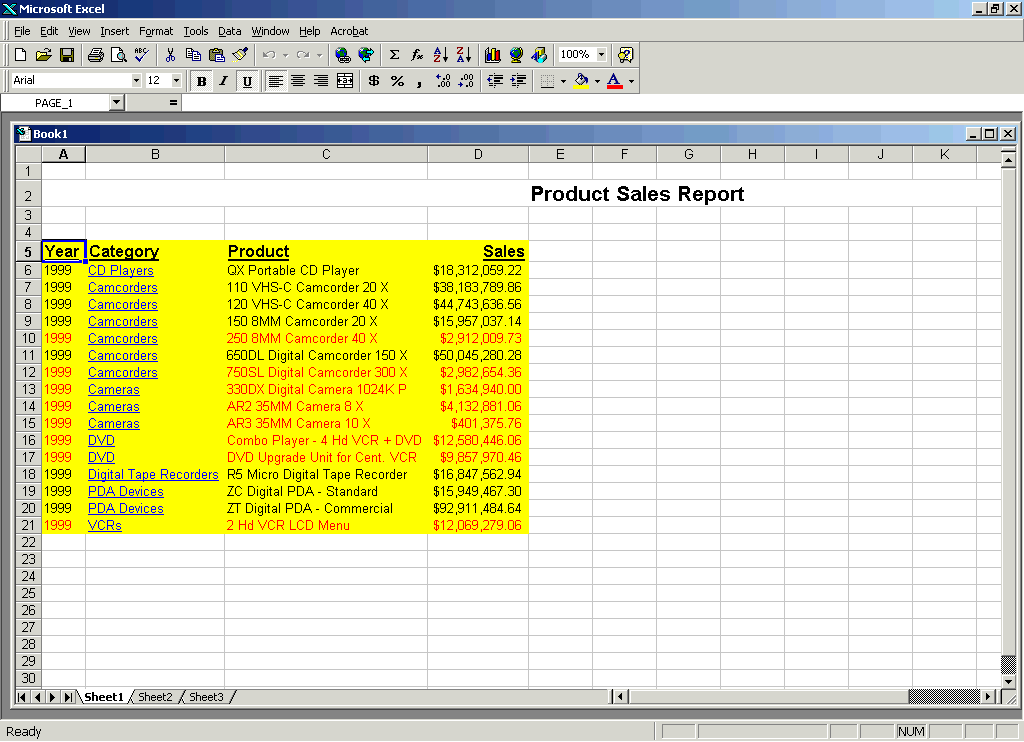
- Now that the data has been pulled into the spreadsheet, you
can add features such as formulas, images, charts, macros, etc.
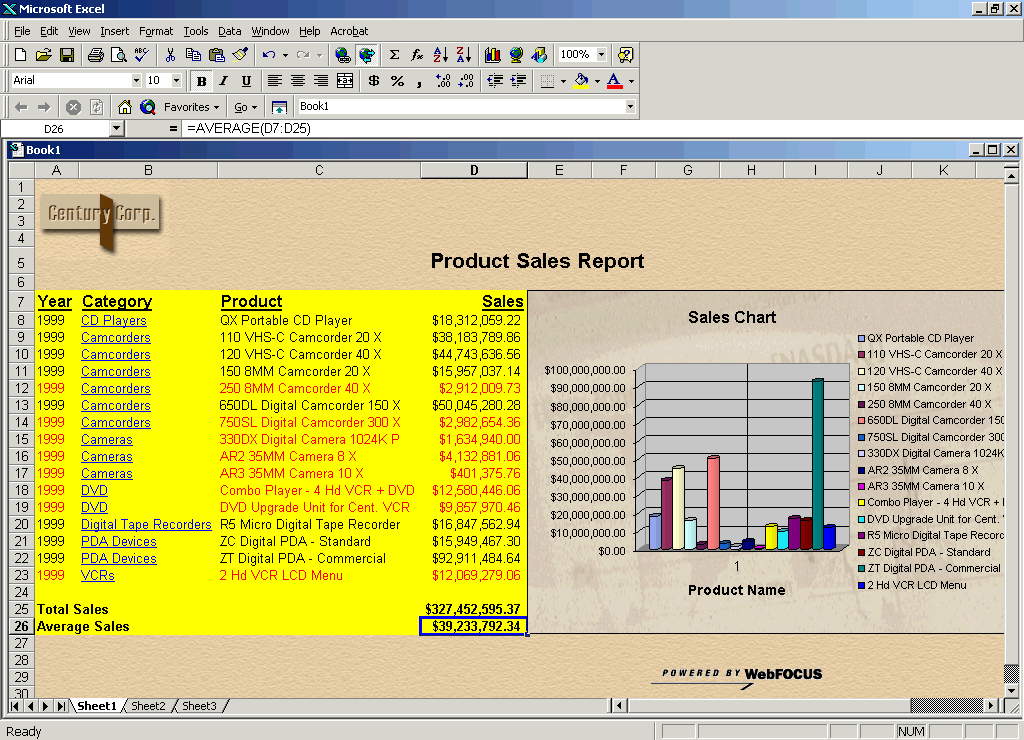
You can now
save this spreadsheet locally on your PC, save it to a shared network
drive where multiple users can access the information, or deploy
it within your web application. See Deploying a Worksheet With a WebFOCUS Web Query.
